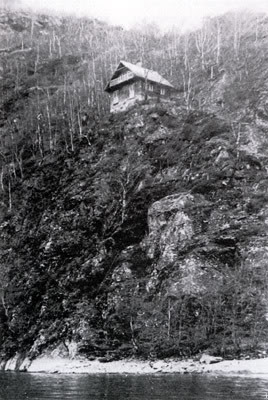There is no landscape (whether natural or thought) that is not inscribed by history. Philosopher Martin Heidegger’s (1889 -1976) connection with a specific locale in the Black Forest south of Freiburg; Todtnauberg, and a particular building; the wooden hut built for him in the 1920s, is well documented. It was here that the poet Paul Celan visited him in 1967. As a place, it reflected and articulated Heidegger’s concerns with, temporality, rootedness and the thinking of Being. For Heidegger the relationship between thinking and the physical experience of a locale were intrinsic to the process of temporality and sense making. His analogy of ‘walking a forest path’ proposed that exploring by walking allows the territory traversed to be the guide to both exploration and thought.2
On the steep slope of a wide mountain valley in the southern Black Forest at an elevation of 1150 meters, there stands a small ski hut. The floor plan measures six meters by seven. The low hanging roof covers three rooms: the kitchen which is also the living room, a bedroom and a study. Scattered at wide intervals throughout the narrow base of the valley and on the equally steep slope opposite, lie farmhouses with their large over-hanging roofs. Higher up the slope the meadows and pasture lands lead to the woods with its dark fir-tress, old and towering…This is my work world…
Why Do I Stay in the Provinces? Heidegger in Sheehan, 27
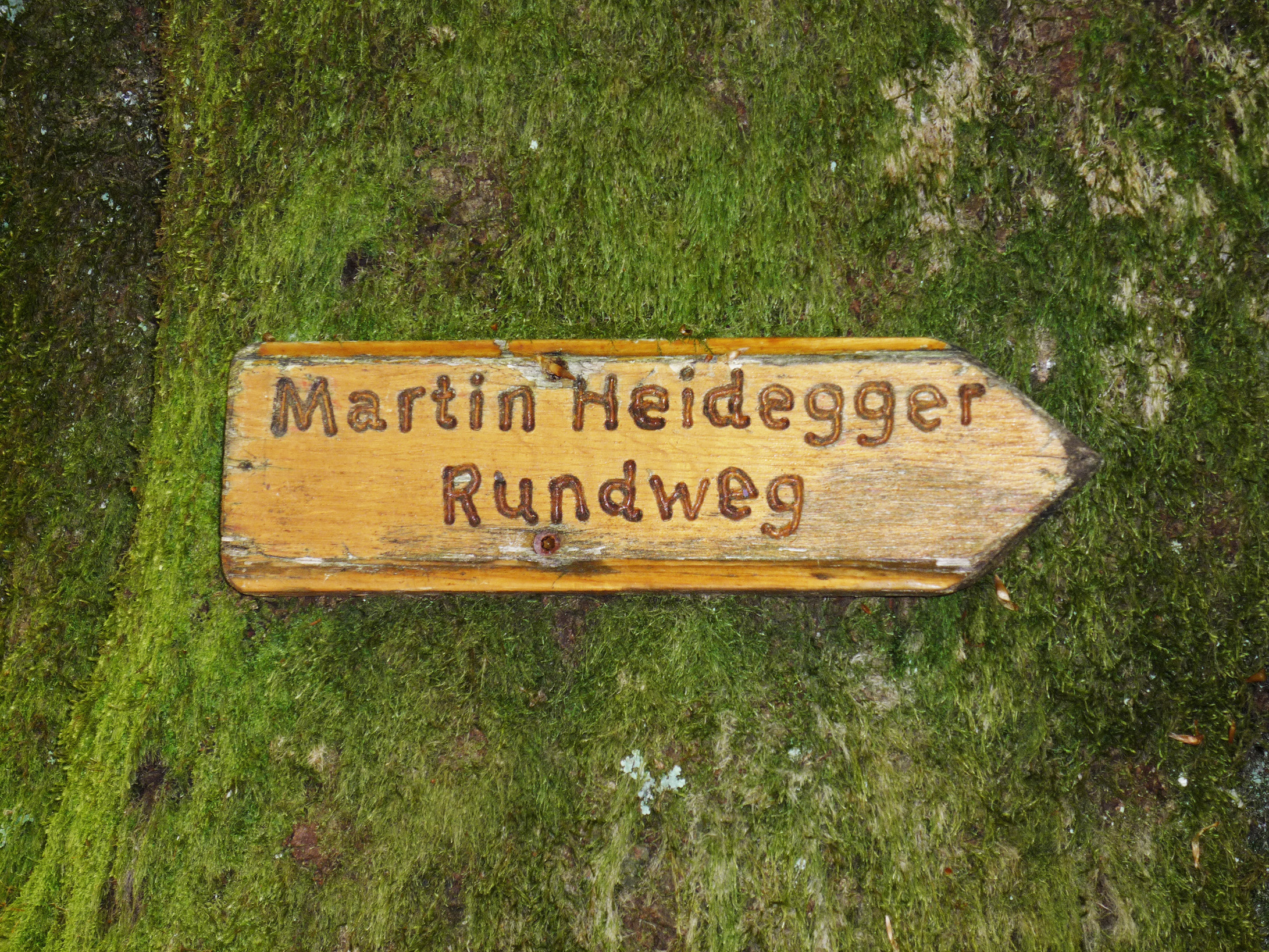
In this text I will explore some possible interpretations of this small shingle-clad building, situated on the northern slope of a secluded valley in the Black Forest. Further, it will argue that the site of the hut and the ‘site’ of Celan’s poem are inextricably linked by the haunting of the site. In his book, Heidegger’s Hut Adam Sharr suggests that the hut could be interpreted in a number of ways:
In 1922, Heidegger’s wife Elfride commissioned a local carpenter, Pius Schweitzer to build a cabin on land she had purchased on the hillside above Rütte and close to the village of Todtnauberg. This was a small wooden hut (approximately 6 x 7 metres), built for him and situated on the north side of a valley facing south, in the mountains of the Black Forest south of Freiburg and close to the village of Todtnauberg. The hut represented not just a thinking place for the philosopher but also a recreational space for his family and invited guests. The village of Todtnauberg is situated off the main road between Kirchzarten and Todtnau and is today, arguably more notable for its waterfall (at 97m, the highest waterfall in Germany) and as a winter ski resort than it is for the association with Heidegger.
The hut focussed Heidegger’s own sense of rootedness in both a physical location and an imagined sense of belonging and community that he evocatively laid out in his 1934 essay, Why Do I Stay in the Provinces? and later in the Festival Address made in 1966. Certainly the essay, Why Do I Say in the Provinces, emerged at a particular historical moment for Germany and at a particular point in Heidegger’s academic career. In 1934, he had resigned the Rectorate at Freiburg and was seemingly distancing himself from the political machinations of the National Socialist regime. At Todtnauberg he ultimately sought to immerse himself in a rarefied world that brought into close proximity, thinking and manual work. However, there are points in the text where this relationship reflects a further spiritual dimension that suggests the hut was perceived by Heidegger as a monastic retreat for the philosopher. As Tim Cresswell notes in Place: a Short Introduction:
Place as dwelling then is both a spiritual and philosophical endeavour that unites the natural and human worlds. A properly authentic existence to Heidegger is one rooted in place (Cresswell, 2004, 22).
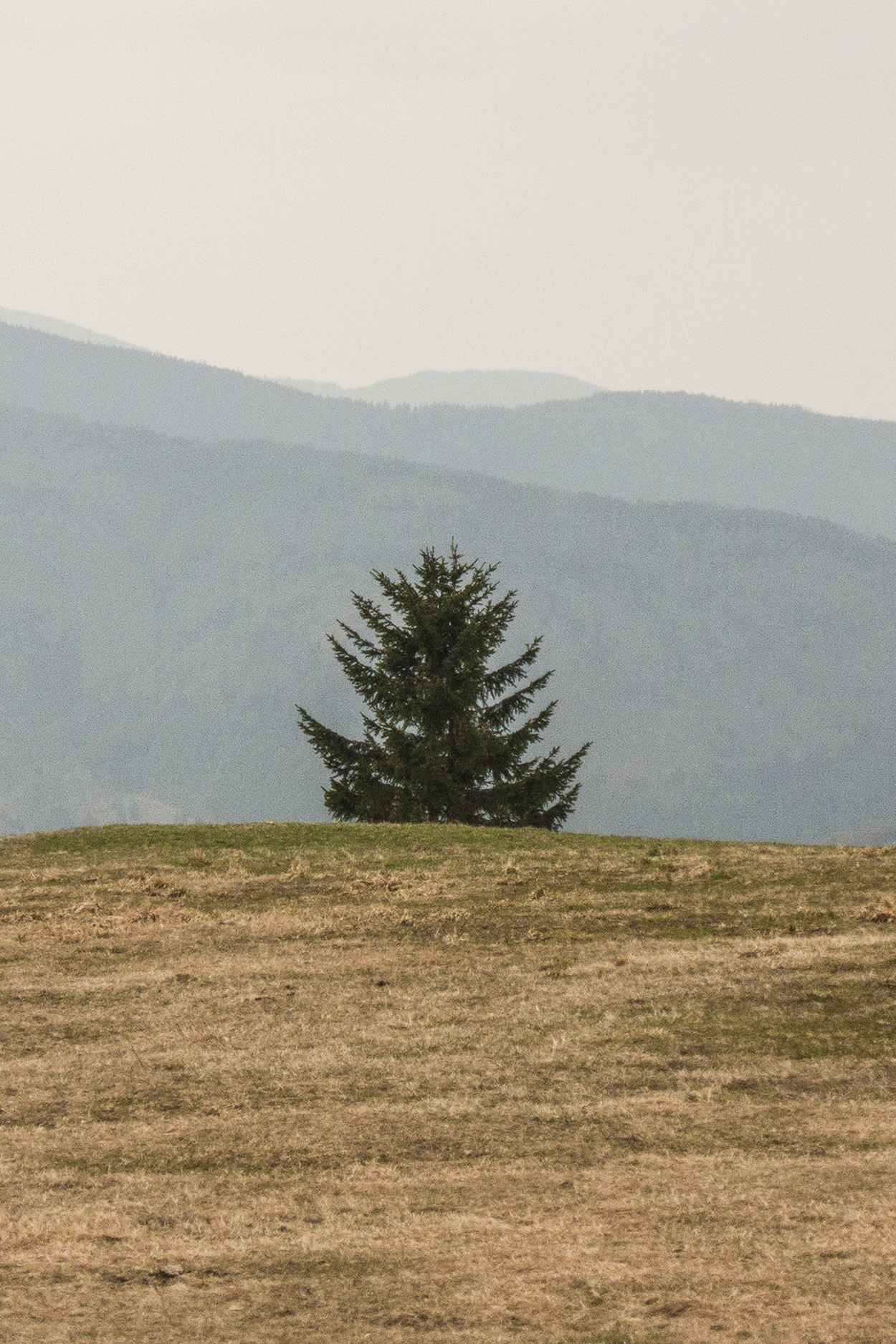
Walking the Rundweg (2010-11)
The hut sits on the on the northern slope of the valley, facing south and overlooking farmland and the hamlet of Rütte. It is one of several properties situated on this ridge and remains (to this day) in the possession of the Heidegger family and therefore a private residence. From below it is partly obscured by a small stand of trees planted on level ground at its right hand corner and from above by a more substantial copse to the left of the property.
The rundweg is a concession to the ‘Heidegger pilgrim’ who makes their way on foot or by car or public transport to this locale in order to attempt to engage Heidegger’s ‘work world’. Robert Mugurauer asks: “what goes on in Todtnauberg that is so special? He answers: Perhaps the chance to retrieve and keep lost idioms and to experience that still robust way of life and speaking? Perhaps an openness to strangers, and a possibility of insiders coming to accept outsiders as belonging? The giving of region, its locality, dialect, intertwined natural and communal rhythms: the giving and receiving of the belonging together- that constitute home and homecoming?” (Mugurauer, 526)
The rundweg allows the visitor a certain ‘access’ to the hut while maintaining some semblance of privacy (signage specifying the family’s desire to keep the uninvited visitor at a distance). Importantly, modern transport links have made the hut and rundweg more accessible than in Heidegger’s lifetime (a regular train from Freiburg takes one to Kirchzarten where a bus heads into the mountains, dropping one at Todtnauberg’s Rathaus – a journey of just over an hour).
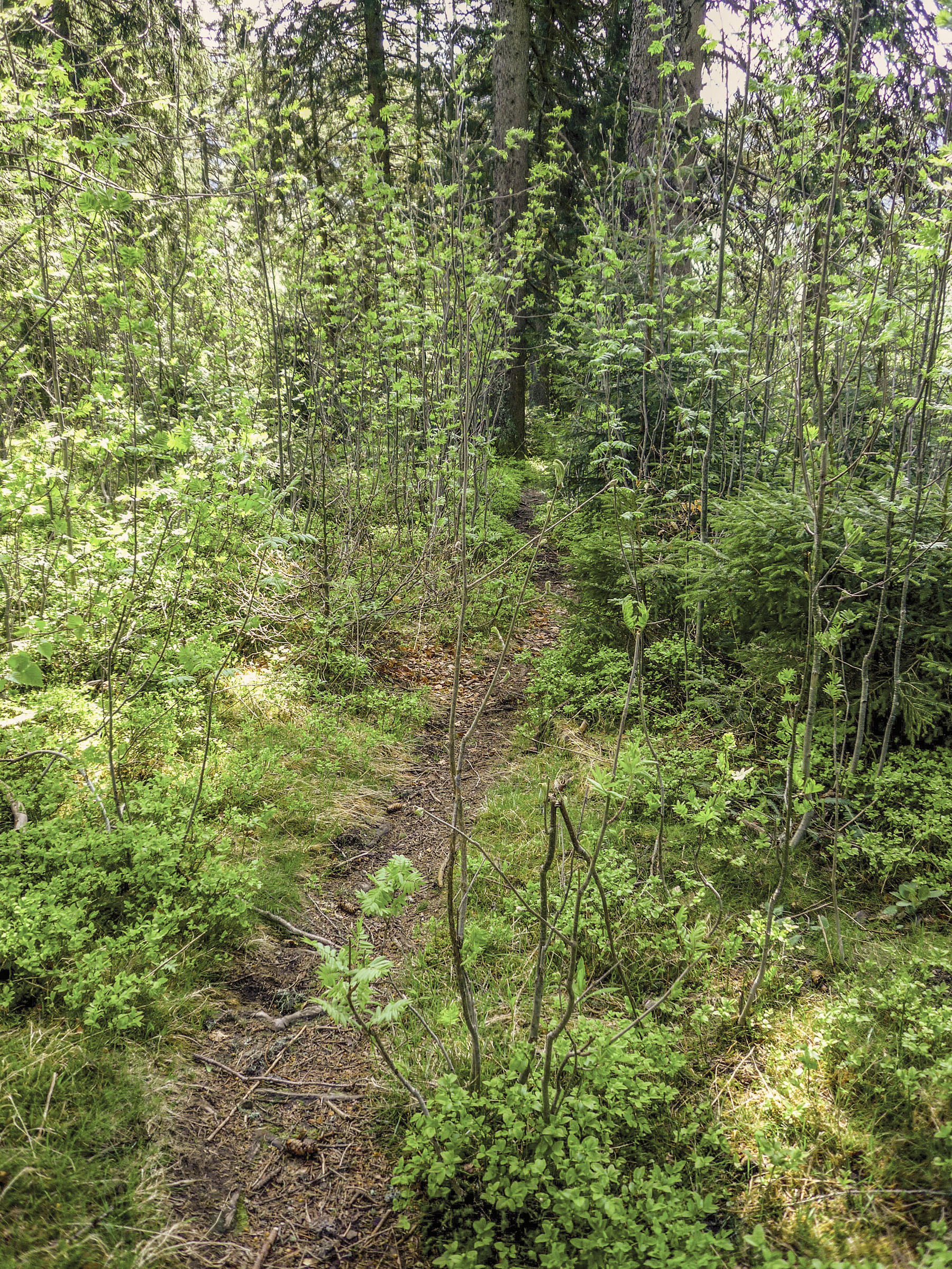
However, historically it was a difficult place to get to from Heidegger’s permanent home in the Rötebuckweg in the northern suburb of Freiburg-Zähringen. Heidegger’s wife, Elfrede noted in 1923:
Reaching the cabin at Todtnauberg was an arduous business, particularly in winter. There were various ways of getting to Todtnauberg: by train to Hinterzarten and from there on foot or by ski over Rinken, Feldberg and Stübenwasen; by train via Lörrach up the Wiesen Valley to Totnau and from there on foot up a steep slope; by train to Kirchzarten and from there by carriage via Oberried and Notschrei…All these routes were arduous, especially in adverse weather conditions (E. Heidegger in Heidegger, 89).
My first journey is in spring 2010. I arrived in Germany with only a sketchy contour map of the area found on the internet. Once in Todtnauberg, I approached the hut from the valley floor, having started at the tourist information building in the village. The hut appeared almost unexpectedly above me, partially hidden by trees and looked as if it had been repainted. However, on closer inspection, it was evident that it had been recently re-shingled and was as yet, un-weathered. This was a strange moment; a realisation that the hut I had committed to memory from so many other photographs had changed its appearance.
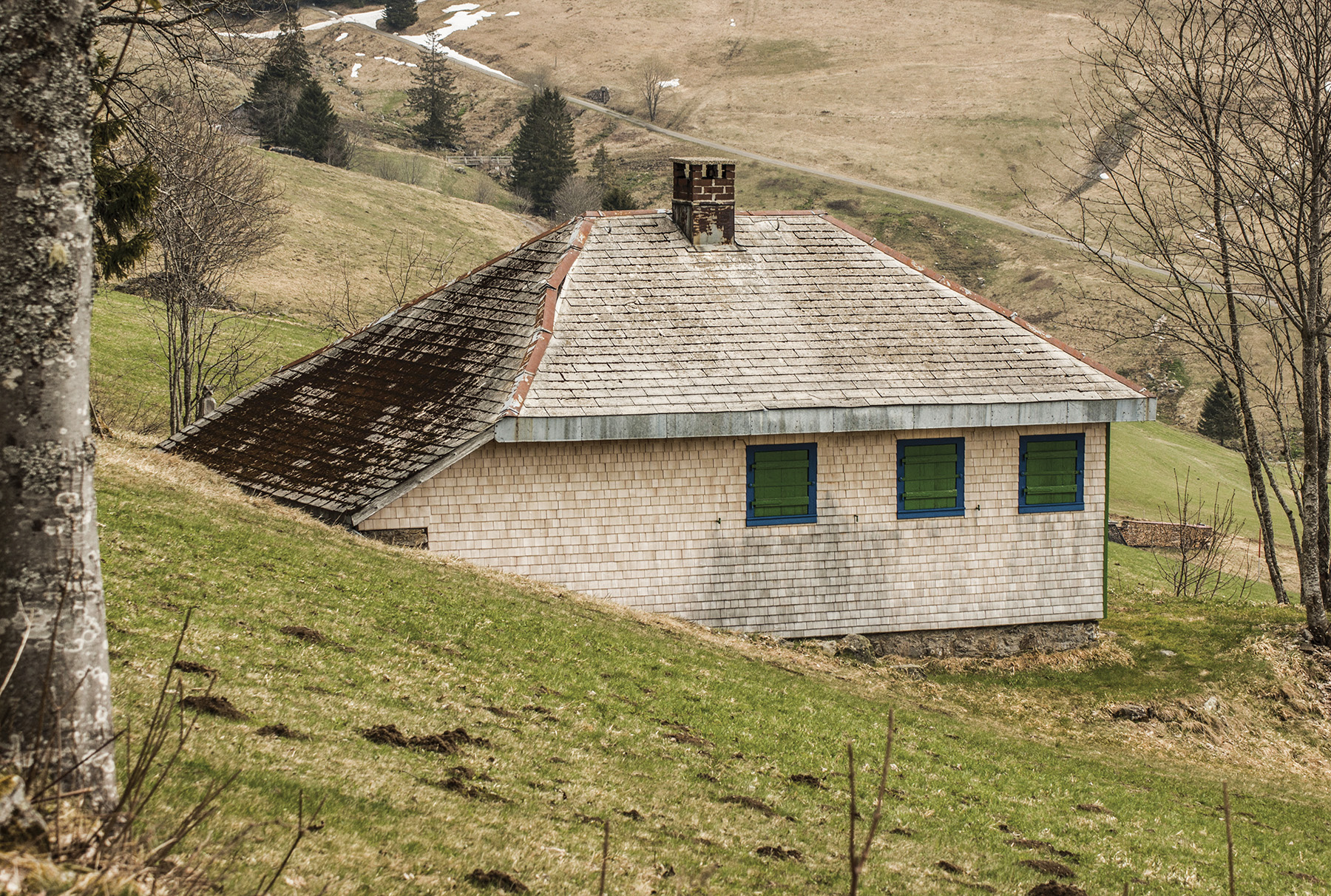
On my second visit, I followed the formal route of the Heidegger Rundweg (having picked up a map from the local information centre in Todtnauberg). It begins on the outskirts of the village and at the rear of a youth hostel, heading east, looping down to the hut and then following a well laid out route around the valley perimeter returning to the start point; a walk of approximately 6.4 kilometres. The route is generally well signposted and is punctuated by illustrated information boards providing details about Heidegger life and his relationship to the hut and the landscape.
The first of these information panels is at the start of the walk and the second is found opposite the Jacobuskreuz along with an inscribed wooden panel – “Im Denken wird jeglich Ding eisen und Langsam” (this translates as; “In thinking all things become solitary and slow). From here the route takes you along a car-wide track east along the northern rim of the valley before a small wooden sign (Wegmarken) directs you to down a narrow footpath to the right into the trees. This short walk through tree cover leads to a gate into a meadow from which the roof of the hut is now visible. Crossing the meadow, the hut emerges from the hillside the blue and green of its shutters and window frames prominent against the starkness of the new shingles. (The hut is unoccupied and the shutters closed on this and every subsequent visit I have made)
A third information board is positioned to the right of the gate down to the hut. From here the Wegmarken directs you past the rear of the hut (noting the conspicuous privacy notice attached to a tree within the fenced- off area surrounding the hut), across the waterlogged ground around the stream that feeds ‘the well with the star die on top’, and rising steadily back up to the main path that continues east along the valley edge. It is here that Paul Celan’s poem Todtnauberg is most prominently in my thoughts. Pierre Joris’s translation of the poem reads:
Arnica, eyebright, the
draft from the well with the
star-die on top,
In the
hütte,
written in the book
– whose name did it record
before mine –?
In this book
the line about
a hope; today,
for a thinker’s
word
to come,
in the heart,
forest sward, unleveled,
orchis and orchis, singly,
crudeness, later, while driving,
clearly,
he who drives us, the man,
he who also hears it,
the half-
trod log-
trails on the highmoor,
humidity,
much
To commemorate his visit, Celan wrote in the Hütte guest book:-
“In the hut-book, looking at the well-star, with a hope for a coming word in the heart. On 25 July 1967 Paul Celan.”
Todtnauberg is both an aesthetic experiment in language and a place haunted by partial erasures. Sharr argues that:-
Celan’s appreciation of Heidegger’s mountain life was seemingly mediated by his imaginings of what had happened there before. He could not join the philosopher in his most intimate landscape without speculating who might have travelled there in different times and what had been discussed, without intense feeling for the role of the past in this meeting. (Sharr, 84-85)
Celan’s asks a question in the poem; ‘who’s name did it record before mine? This identifies co-signatory’s that would have previously signed their names in the hut guest book and in so doing traced their presence there. As indicated by the ‘hope’ noted by Celan in the guest book. This is borne of what might be interpreted as a pervading and embracing ‘silence’ that preceded the inscribing of the poem. This determined a certain kind of absenting, implicit in the poem’s inscription, translation and re-inscription.
This silence ‘spoke’ and continues to ‘speak’, remaining at once voluble and yet silent in the various translations that have been published since its initial inscribing and in the immediate aftermath of that encounter between the ‘poetic thinker’ (the German Denker) and the ‘thinking poet’ (the Jewish Dichter) in the valley above Todnauberg. In his essay Catastrophe, Philip Lacoue-Labarthe states:
The place of poetry, the place where poetry takes place, every time is the place without place of the intimate gaping – something that must certainly be thought as the pure spacing which places (do not) suppose and which upholds them with no hold. (Lacoue-Labarthe, 140)
Claudio Magris argues that even Heidegger’s repeated “over-emphatic identification with a familiar and immediate community – its woods, its hearth, its dialect…was an implicit claim to a monopoly of authenticity…” (Magris, 45)
Within this familial locale, Magris also suggests that there must always have been elements of uncertainty and anxiety:- “… without loss and disorientation, without wandering along paths that peter out in the woods, there is no call, there is no possibility of hearing the authentic word of Being.” (Ibid, 46)
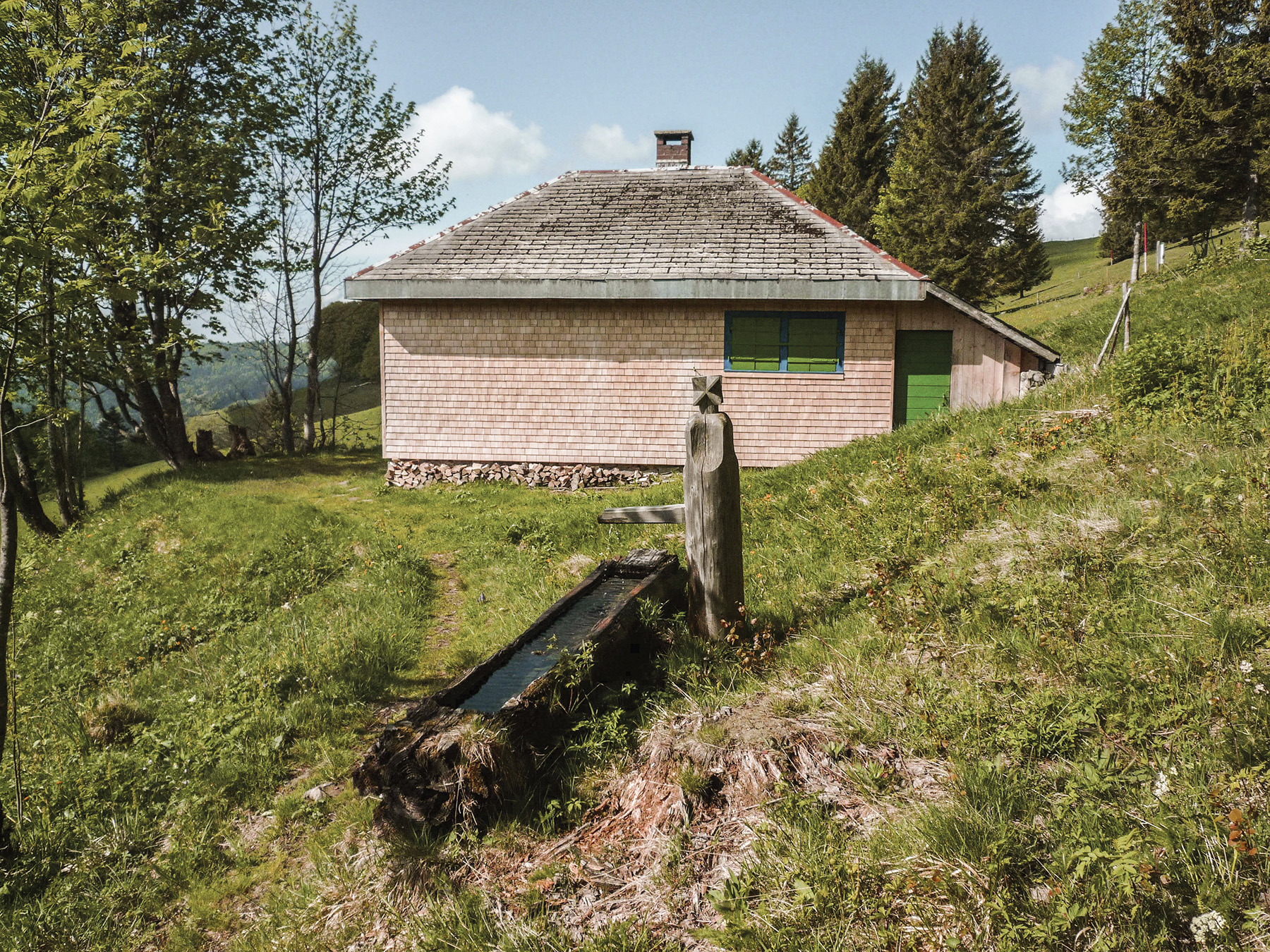
I propose that a landscape haunted by loss and disorientation perhaps explains why the poet Celan, lacerated by the Nazis exterminations and its aftermath, was able to set foot on the path to Heidegger’s cabin, to climb to that cabin and to attempt a genuine dialogue with the ex-Rector of Freiburg University, who in 1934 had put his philosophy at the service of the newly fledged Reich.
“The Black Forest surrounding the hut had become a transcendental, universal landscape of philosophy. In the luminous clearing in the wood in which… there is nothing that can be grasped, but only a horizon within which things appear…” (Ibid, 47)
This suggests a haunted topology manifest in the folding, unfolding and refolding of histories in both poem and locale. It indicates, as Celan noted in his ‘Meridan Speech of October 1960, an animation of ‘tremors and hints’ that are both inclusive to and exclusive of the ‘poetic event’. These are the tracings of ‘what is’, ‘what has been’ and ‘what will be’ – the variance of markings that suggest visibility of invisibility transcribed and partially erased in the plurality of the poem and the ‘place’ as the ‘locale’ of the hut.
Dennis J. Schmidt in his essay on Celan entitled, ‘Black Milk and Blue’, proposes that:
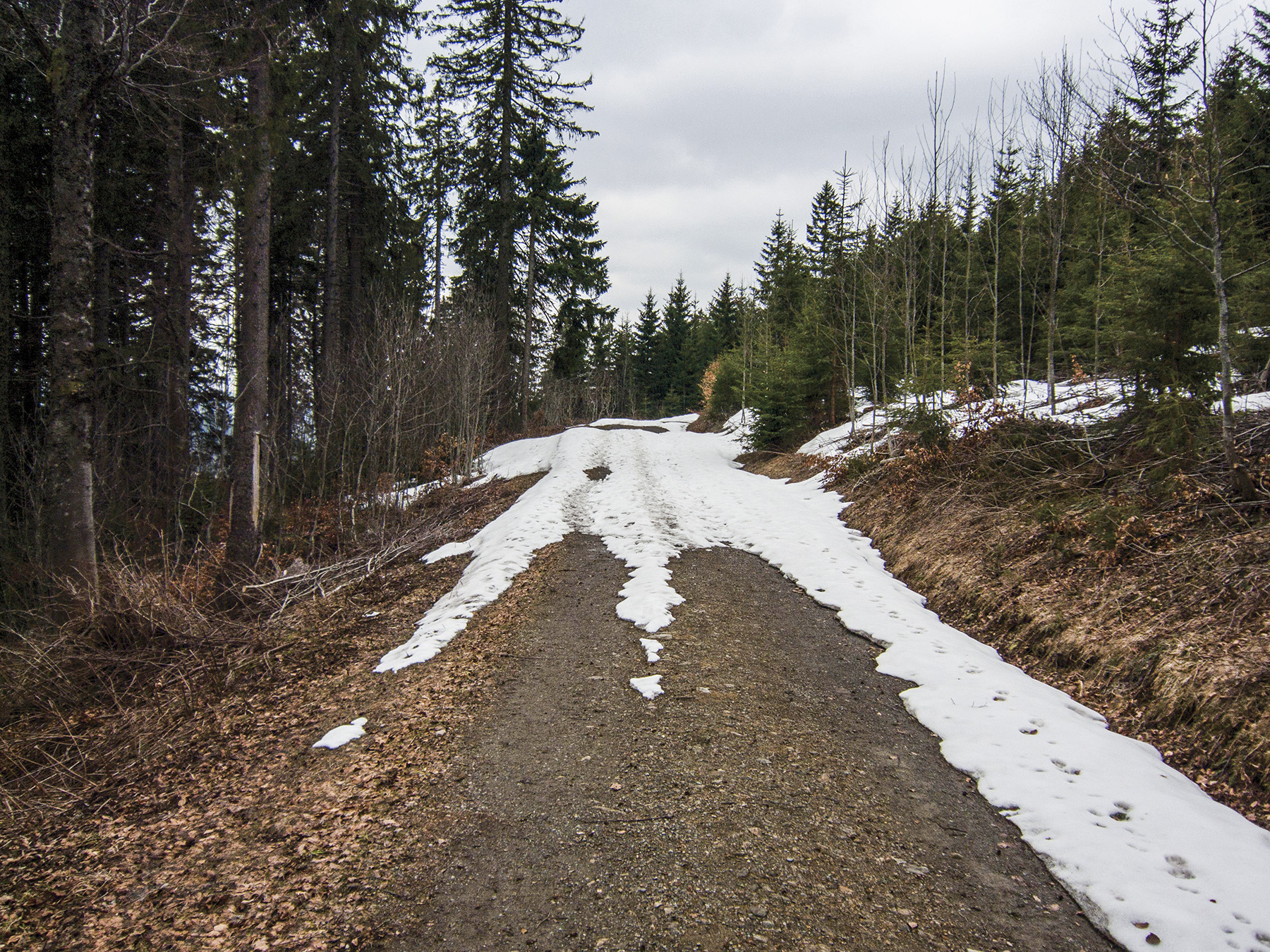
What is traced in Celan’s poem looks back to Heidegger’s ‘conspicuous’ silence in the aftermath of the fall of Third Reich in 1945. What was unvoiced was as an explanation of his contentious involvement with the National Socialist movement. This is the overarching spectre haunting the site of the hut that prompted the writing of ‘Todtnauberg’. It pervades the anticipatory note, not only in Celan’s poem but also in the comment he inscribed in the visitor’s book. However, I propose that such a consideration, though valid, is just one of several historical traces, which singularly anticipate but perhaps do not fully address the complexity of the many unvocalised possibilities that haunt Todtnauberg. Philippe Lacoue-Labarthe suggests that:
‘Todtnauberg’ is really barely a poem; a single nominal phrase, choppy, distended and elliptical, unwilling to take shape, it is not the outline but the remainder – the residue – of an abortive narrative. (Lacoue-Labarthe, Poetry as Experience, p.35)
From this we can construe the ‘landscape’ of the poem is less of a ‘literal landscape’ than it is an interpretation of a ‘terrain’. What do I mean here?
In Ulrich Baer’s book Remnants of Song: Trauma and the Experience of Modernity in Charles Baudelaire and Paul Celan, Baer makes a useful distinction between the terms ‘landscape’ and ‘terrain’. He argues that ‘landscape is a symbolic setting for an individual’s passage through time; ‘a continuous and coherent whole’, whereas ‘terrain’ is a fragmentary experience onto which a coherent sense of self may no longer be projected.
In Celan’s poem, the very notion of a ‘landscape’ has been actually and symbolically tainted by the fascist past and it serves as an imperfect setting for events that fractured Celan’s past. Recollections of this past have to be placed in a terrain that can be described only in abstract fragments – ‘grass written asunder’, ‘forest meadows, unleveled’ – rather than a coherent whole. Celan’s poem presents us not with a coherent experience but with its remnants, its shards.
It is the actual geographic setting of the encounter that harbours the crypt or secret of Heidegger’s involvements, and subsequent silence about Germany’s fascist regime. In the words of the poem, this painful and finally irreconcilable past lies buried just below the wet forest soil on which Celan and Heidegger take their walk.
Emmanuel Faye in his book, Heidegger: the Introduction of Nazism into Philosophy argues that Celan’s visit to the hut was not in anticipation of reconciliation but of redemption. He suggests that in leading Heidegger on a walk to the ‘quagmire of the Black Forest’, where supposedly, the Nazis had set up their camps (Faye, p.306), Celan wanted to show Heidegger that the earth of the Black Forest did not consist solely of granite (that determining ‘substructure’ as indicated in Heidegger’s Schlageter address of 1933), but was fluid and indeterminate. The very landscape that day reflected the outcome of the conversation between thinker and poet. The path on which they walked became so sodden that they were forced to retreat to the hut.
This poses the question as to whether the ‘purity’ and simplicity of Heidegger’s retreat in the Black Forest was (and arguably remains) tainted by the political past. Baer notes:
“Heidegger’s failure to address his past involvement in fascism is revealed by drawing on a word’s propensity to assume regionally specific connotations. Because a speaker from one part of Germany may hear an equivalent of ‘fascine’ where others hear nothing but ‘meadow’, Celan effectively employs dialect – the link of location and a sense of particularised speech – against itself.” (Ibid, p.229)
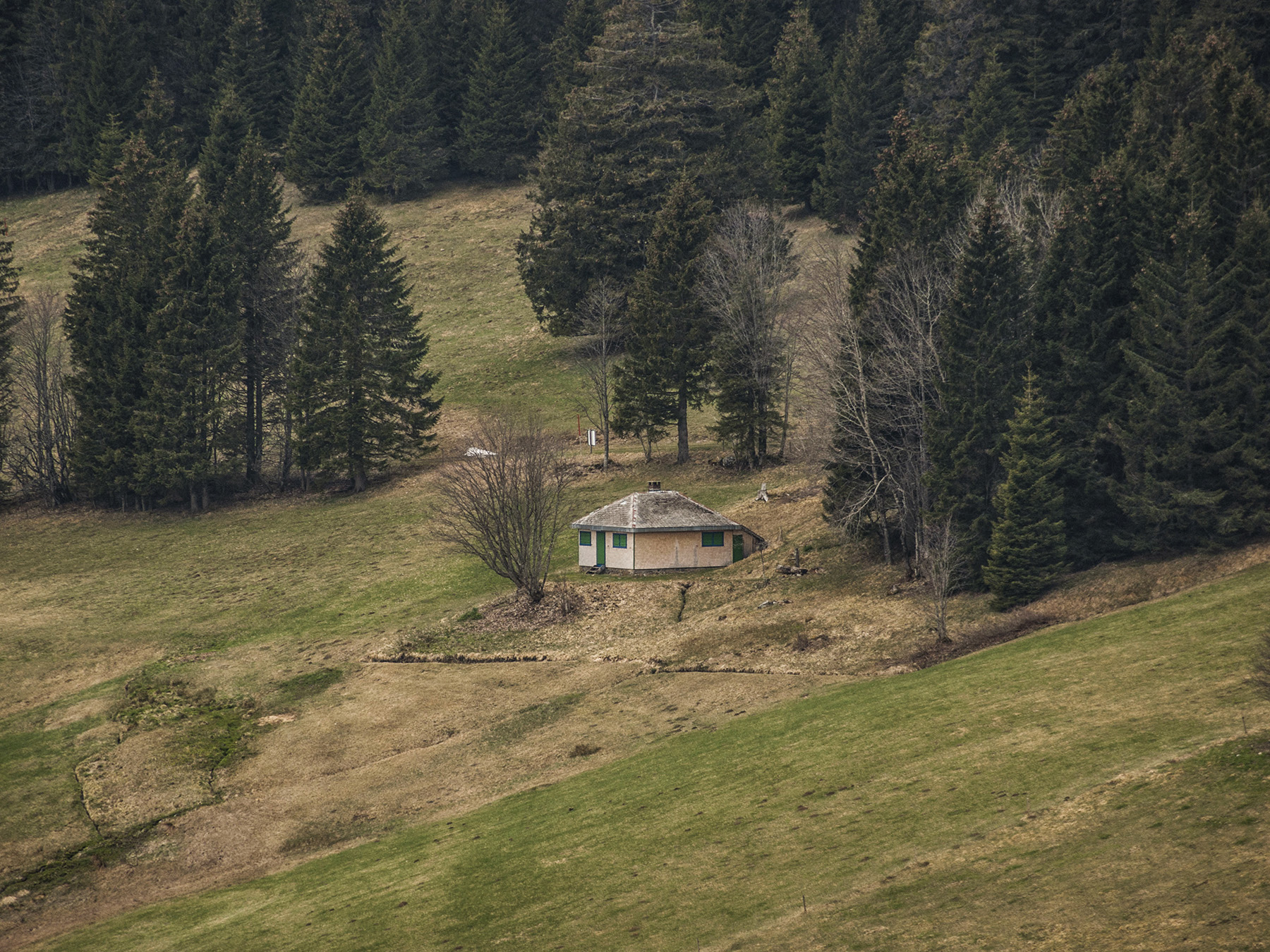
A term that might indicate the complexities of such a lingual encounter in Celan’s later poems that is both poetic in background and psychological in utterance would be in the form of a lack of fluency - a‘disfluency’. Language is both pressured into silence and pressed by silence. It is rife with traces and fragments that interrupt and disrupt it. In his text Aesthetic Theory, Adorno acknowledges the pressure inherent in Celan’s poetry, claiming that:
Celan’s poems articulate unspeakable horror by being silent, thus turning their truth content into a negative quality. They emulate a language below the helpless prattle of human beings – even below the level of organic life as such. It is a language of dead matter; of stones and stars … Celan writes poetry without an aura. (Adorno, p.444)
Emmanuel Faye elaborates on Heidegger’s ‘silence’ as not one of the guilt of association, but of incomprehension. He suggests that “according to Heidegger, no one died in a death camp, because none of those who were exterminated there bore within their essence the possibility of death.” (Faye, p.305)
Here Faye draws on an interpretation of one of Heidegger’s Bremen Lectures (1949) entitled, ‘The Danger’ (Die Gefuhr). For Faye, this is no longer a revisionist view of the Holocaust, but a negation. None died in the death camps because none were able to die. Those liquidated could not be saved by Being – they were not ‘mortal’ and therefore not ‘human’. They could not ‘die’ because they could not even ‘live’.
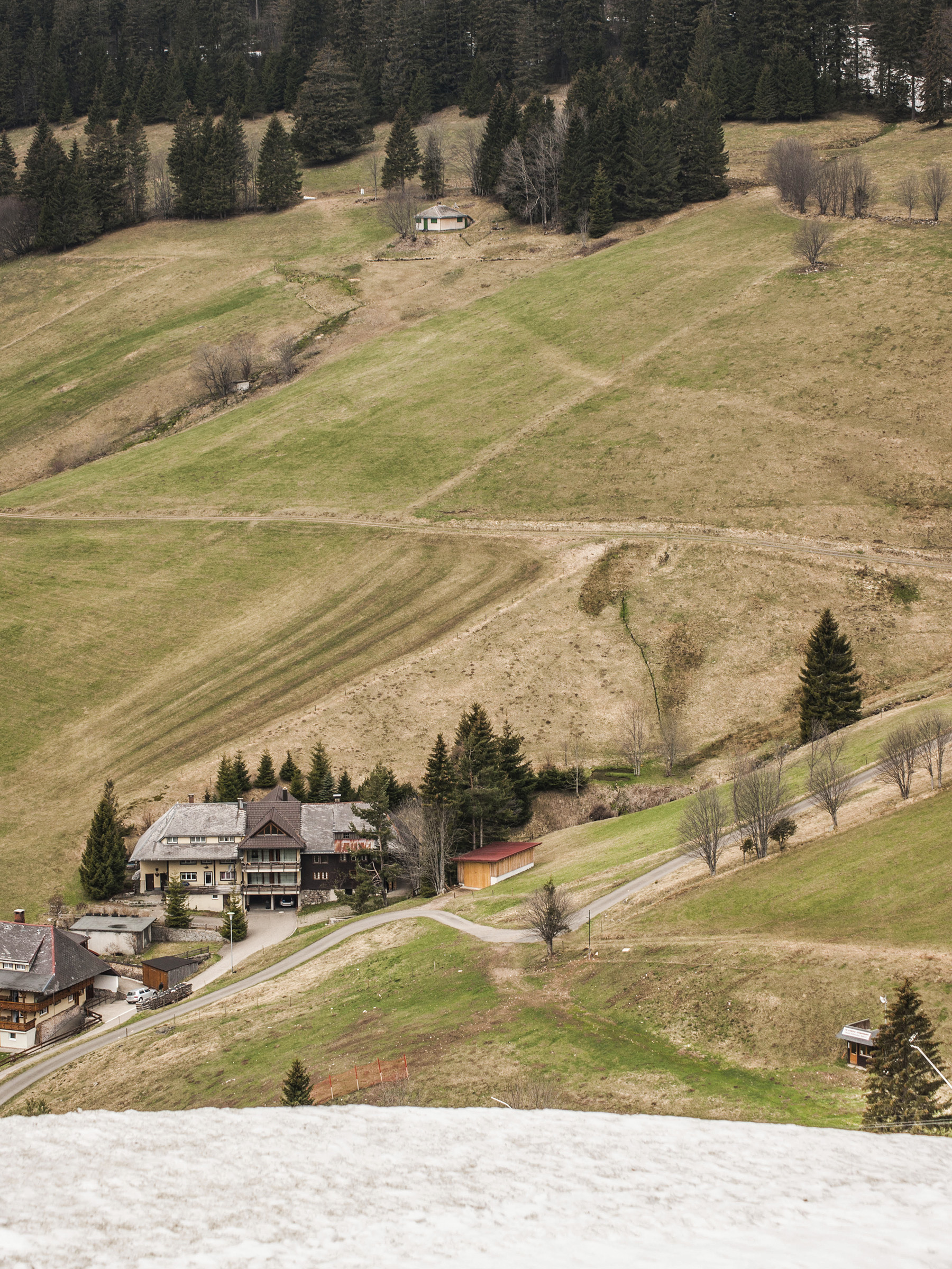
Heidegger apparently attacks the very ‘being’ of those exterminated. In showing that they were always already ‘nothing’, it is clear to see in Faye’s interpretation, how Heidegger could construe that ‘nothing’ happened to ‘nothing’. The poem does not attempt to express the ‘illness of the poet’ but rather the ‘madness of the thinker’.
The poems palimpsestic nature in relation to the site of the hut presents a number of potential temporal anomalies. As I walk, I am conscious of the rootedness to the soil that Heidegger advocated as part of a place-based identity centred at Todtnauberg, was not just a withdrawal into a fantasy of dwelling, proximity and neighbourliness but also a kind of exclusion. The distinctiveness of this exclusion is that it identifies those who are not directly linked to a place or location as ‘other’. Neighbourliness ‘speaks’ and in the act of speaking, excludes those who are unable to engage with the speech patterns and dialect of a location. Dialects are at once inclusive and exclusive; they are an event of both location and dislocation. In the poem, Celan refers to the ‘event’ of walking (‘the half-trod log-trails on the highmoor’). This prompts me to think of writer and walker, Robert MacFarlane, who identifies the word shul from Tibetan Buddhism as defining “a mark that remains after that which made it has passed by: footprints are shul, a paths is shul and such impressions draw one backwards into awareness of past events” (MacFarlane, 28).
As I walk east towards the Feldberg, the hut remains out of sight until the path turns south-east and I look back down the valley. Here it emerges from the edge of a tree line and is now more or less continually in sight for the rest of the walk. The path snakes east again and leads to a junction where a second path continues eastward the 3 kilometres to the Feldberg. However, the rundweg turns west at by third information board and traverses the southern rim of the valley back towards Todtnauberg. I am now looking north-west as I track the hut on the far side of the valley from north-east to north to north-west passing a fourth information board that is almost directly opposite the hut on the northern rim. The path continues past a small chapel (the Fatima Kapelle) before looping back into the valley (heading north-east) and down to the hamlet of Rütte. From here it ascends the north side of the valley (heading north-west) to a final information panel below the hut before rising to the starting point at the youth hostel. From here, I descend to Todtnauberg and the bus stop at the Rathaus.
In Paul Celan and Martin Heidegger; an Unresolved Conversation, 1951-70, author James K. Lyon argues that we should not be too quick to assume that the poem was written as either a judgement in the form of ‘resentment’ or as ‘a disappointment’. He suggests that there is no recorded evidence from the period to suggest such an interpretation is necessarily appropriate. In a letter written by Celan to Werner Weber (editor of the literary section of Neue Zürcher Zeitung), Celan describes the poem as an attempt to ‘register’ (festhalten) or to ‘put on record’; in a detached impersonal fashion. He registers sights and events related to his encounter and conversation with Heidegger. (Lyon, 181)
Lyon quotes from Celan’s letter to his estranged wife written on August 2 1967:-
“On the day after my reading I was in Heidegger’s cabin in the Black Forest with Herr Neumann… Then in the car we had a very serious conversation in words that were unmistakable on my part. Afterwards Herr Naumann, who was a witness, told me that for him this conversation had an epoch-making aspect to it.” (Lyon, 165)
However, Lyon argues that Celan’s tone changed on his return to Paris after the meeting at the hut. This tone becomes more judgemental of Heidegger. In a letter sent to Franz Wurm, dated 25 August 967, he referred to the hut as “Denkhütte” (literally, his ‘thinkers hut’) at Todtnauberg. Lyon suggests that Celan’s wordplay is not intended as a compliment but a ‘jarring paradox with an implicit criticism’ (Lyon, 175). The association of a ‘hut’ with a certain class of people, and ‘thinking’ with another might suggest that Heidegger was being pretentious. Lyon goes further to suggest that Celan’s comment is a more oblique reference to the modest dwelling circumstances of the ‘volk’ in Nazi ideology. In a later letter date January 24 1968, Celan asks whether he should publish the poem or wait for an answer from ‘the one from the mountain’. Here Lyon suggests this phrase has a double meaning – Celan referencing a term used by Hitler’s Reich Chancellery Group of associates during the Nazi era, who referred to themselves as ‘those from the mountain’ alluding to their privileged position that allowed them to visit Hitler at ‘The Eagles Nest’ on the mountain above.
I returned to the Black Forest in April 2012 to revisit the hut. While on previous occasions, I found myself fortunate with the weather (invariably, bright sunshine and dry), on this visit, (slightly earlier in the year) the conditions were much more unpredictable. There was evidently more snow lying and in places along the Rundweg this impacted on the physical act of walking and I have to take more care. Again (as in all previous visits), the valley was largely quiet.
I ascended from the village to the youth hostel under grey skies before turning onto the Rundweg itself at the first information board. As I walked, the amount of winter snow still lying becomes increasingly evident. Looking north and south, the higher pastures are still covered by substantial fields of white. As I reached the Jacobuskreuz, I noticed that the wooden panel with the quote, “Im Denken wird jeglich Ding eisen und Langsam” was missing. I continued east along a vehicle-wide track scanning the tree line on the right hand side for the small wooden arrow marked ’Heidegger Rundweg’ and pointing into the trees. This was also missing, so I made a best guess, selecting what I remembered as the path that lead down through the trees to the meadow immediately above the rear of the hut. As I crossed the style that took me from the trees into the meadow, it was noticeable that the electrified fence that had previously separated the meadow from the hut was missing and there was no gate onto the land that immediately surrounds the property. While the signs requesting respect of privacy remained (although one had now fallen from its original spot and was propped at the base of a tree), the determining sense of privacy was lost with no fence or gate. Again, the shutters of the hut were closed and there was little to suggest recent occupation. I turned north-east and cross the stream leading to the well before re-joining the wider path which was largely covered in compacted snow. On reaching the fork to the Feldberg, I noticed that the information board here was also missing. This, with my other observations of missing signage on the route suggested an ongoing deterioration of the path marking of the Rundweg.
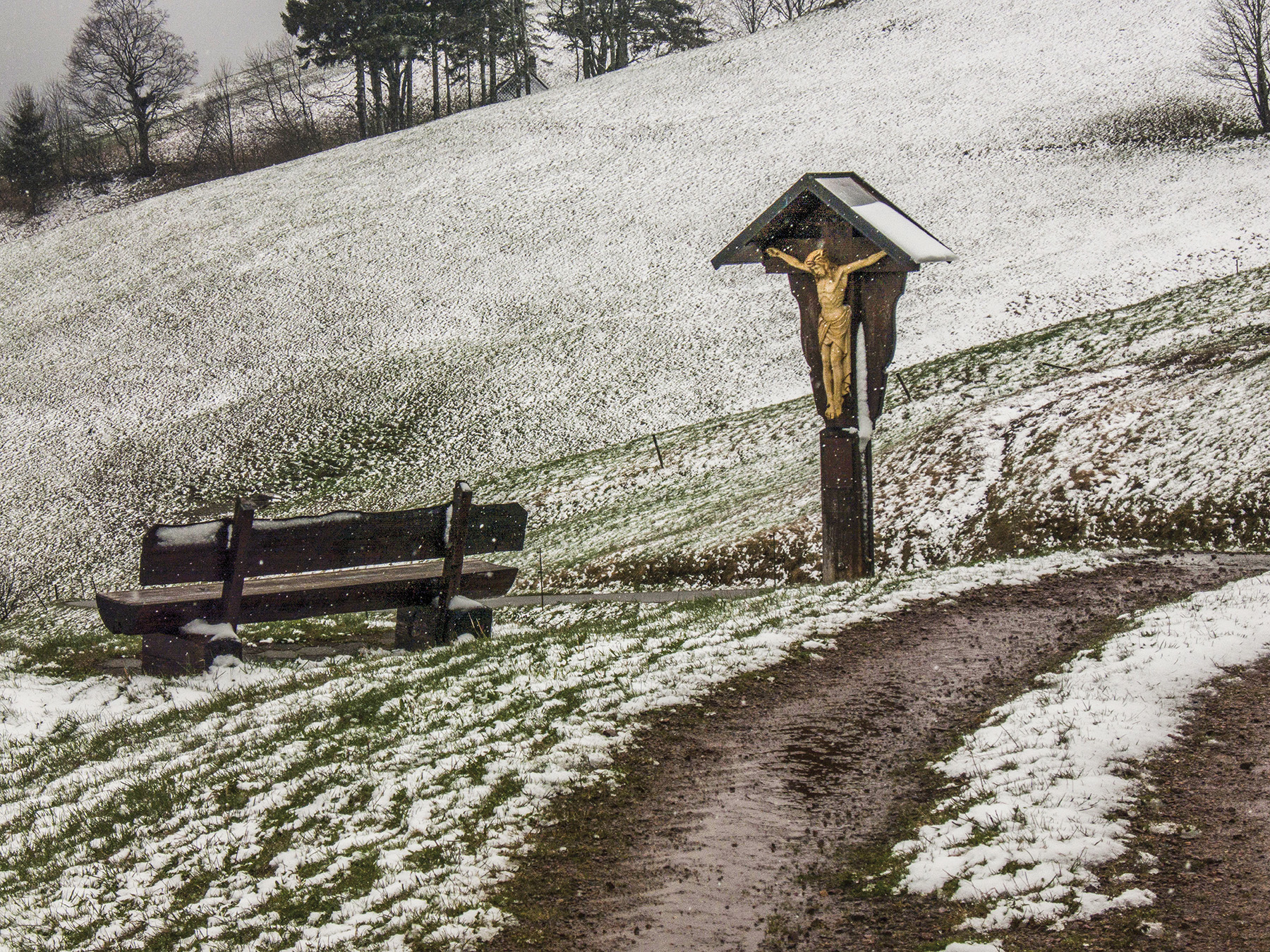
As I headed west along the south ridge of the valley the weather began to close in. Light spots of rain turned to persistent drizzle and the hut on the other side of the valley became indistinct. At the Fatima Kapelle at the far south western edge, the rain was now nonstop and I decided to abandon the last stage of the walk and head back to Todtnauberg via a more direct route. This took me past the village graveyard and exploiting a break in the rain I wandered in and tracked around the space, reading the gravestones, attempting to build up some kind of historical map of who had lived and died here. I found myself thinking of Heidegger’s grave at Messkirch; some 120km east of this spot, and then Celan’s at Thiais, in the southern suburbs of Paris.
Two days later, I made the decision to return and complete the last stage of the walk. The weather in Freiburg was poor and as I got off the train at Kirchzarten and looking south over the mountains, the mist descended and it was hard to judge what the conditions would be like at the hut. The bus ascended in persistent light rain but as we climbed, the temperature began to drop and the rain turned to sleet and finally to snow. I felt I had no option, now I was there and decided to embrace the conditions, leaving the village for the valley and taking a side road that lead me into the valley proper and not the formal start of the walk. This road led down towards the hamlet of Rütte and would enable me to view the hut from below at the last information board on the Rundweg. As I walked the snow falling became thicker and my gloveless hands struggled to operate the two cameras I carried.
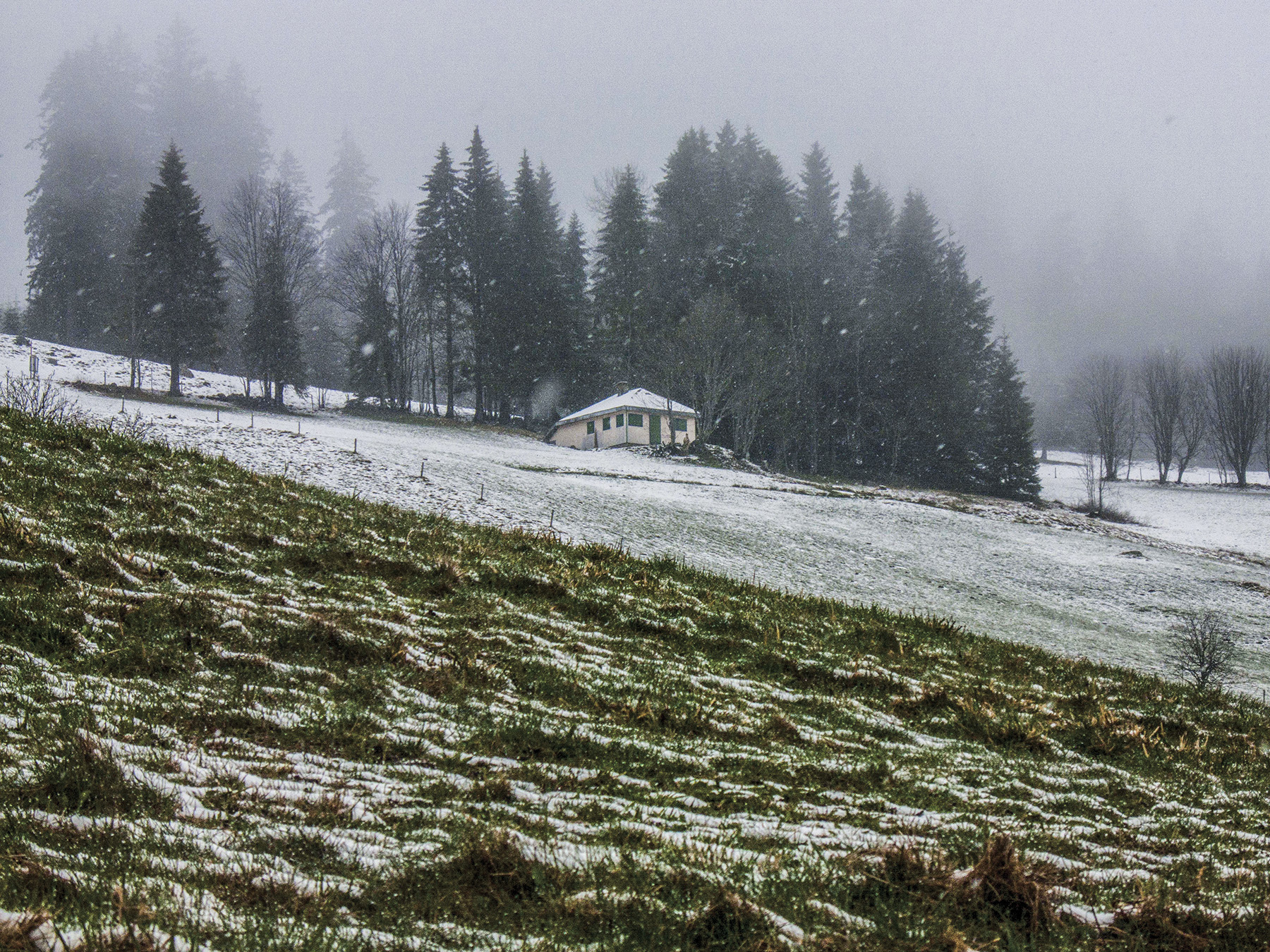
This is the first time that I had experienced the hut in such adverse conditions and it was now that I sensed for the first time, isolation at Todtnauberg that made it so important to Heidegger. As the snow persisted, and I walked the path beneath the hut taking photographs, I was reminded of what Heidegger’s wrote in Why do I Stay in the Provinces?
On a deep winter’s night when a wild, pounding snowstorm rages around the cabin and veils and covers everything, that is the perfect time for philosophy. Then its questions must become simple and essential. Working through each thought can only be tough and rigorous. The struggle to mold (sic) something into language is like the resistance of the towering firs against the storm (Heidegger in Sheehan, 27-28).
I remained in the valley for an hour and a half before walking back to the village and the bus stop. The snow flurries relented a little, but I realised my wait would be longer than I first thought as I had misread the timetable (weekend rather than weekday). After an hour, I was finally sitting in a heated coach watching the rising fluctuations of temperature on the digital readout above the driver’s head as we headed down towards Kirchzarten and the train back to Freiburg.
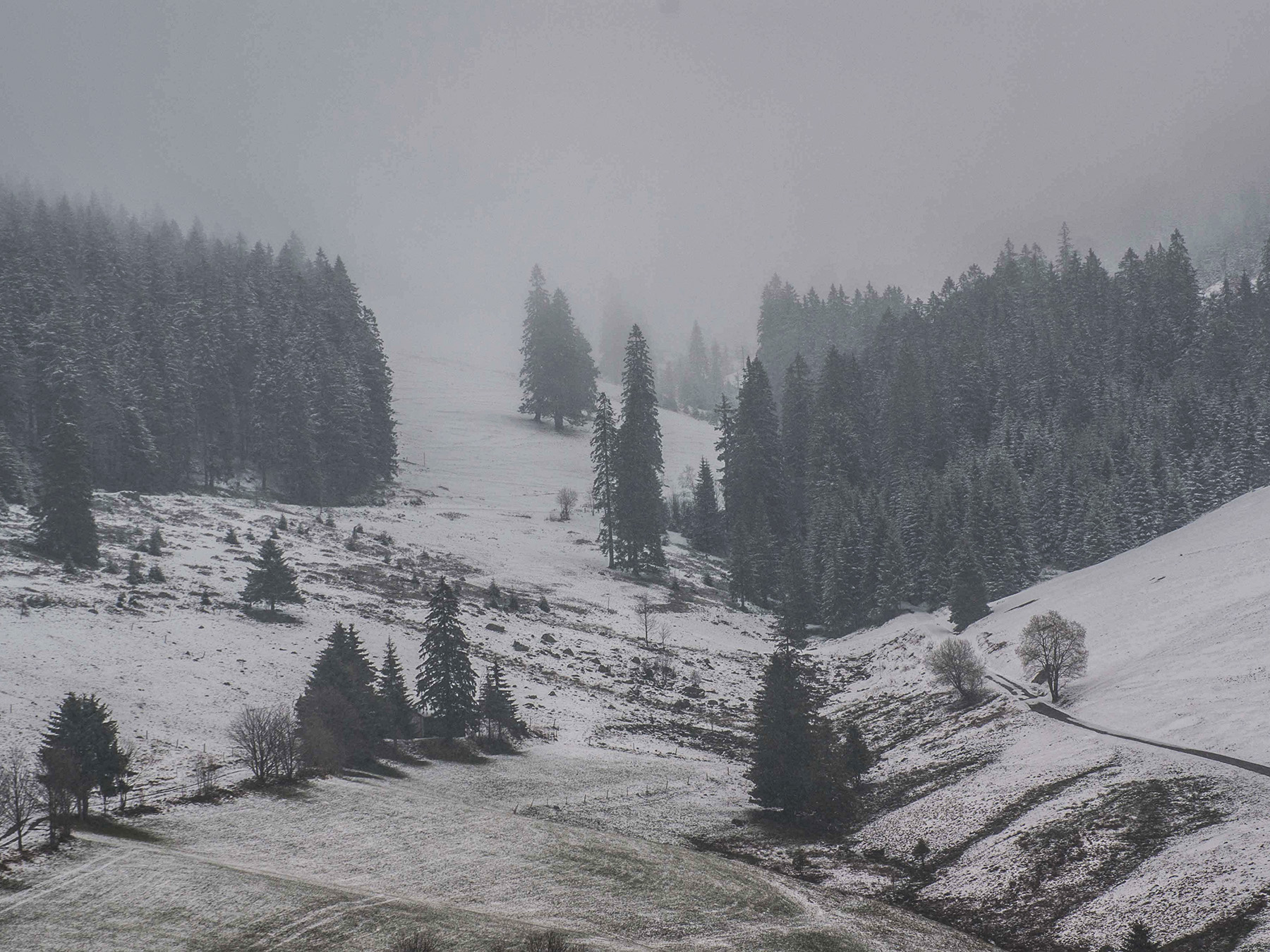
The hut’s relationship to the landscape in which it is situated, suggests a much more complex and rich palimpsestic ‘terrain’. Even today the unassuming wooden building persists as the site of meditations on its multiple histories and interpretations. It is at once both worldy and other worldly.
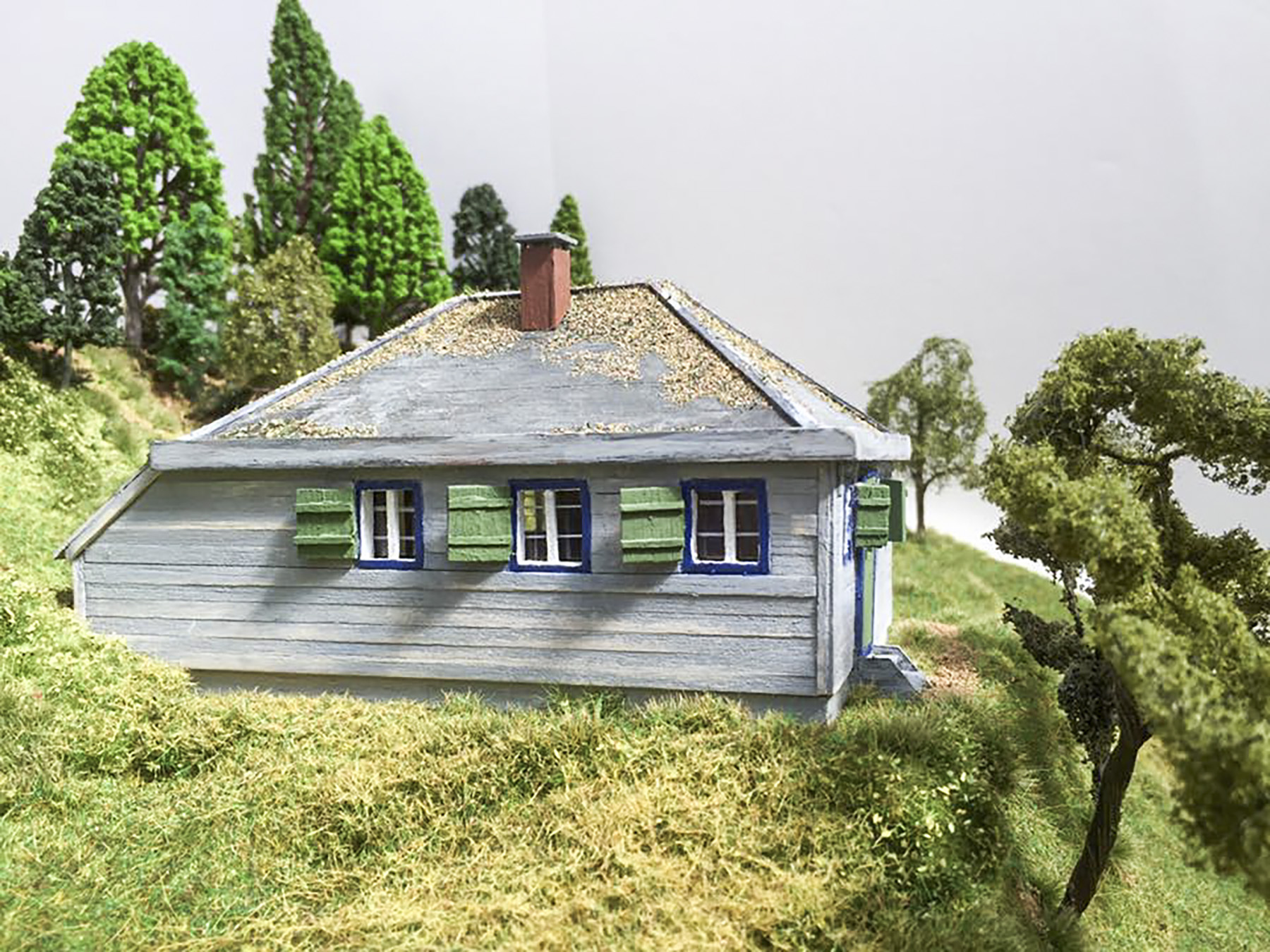
I have explored the landscape of Todtnauberg by exceeding its purely geographic setting. Place and poem are terrains haunted by spectral traces and can only be described in abstract fragments rather than as coherent wholes. This spectral experience of remnants and shards transforms Heidegger’s familial home and Celan’s poem into fractured and residual places where partial erasure ensures that visibility and invisibility, vocal and unvoiced coincide.
Mark Riley, 2016
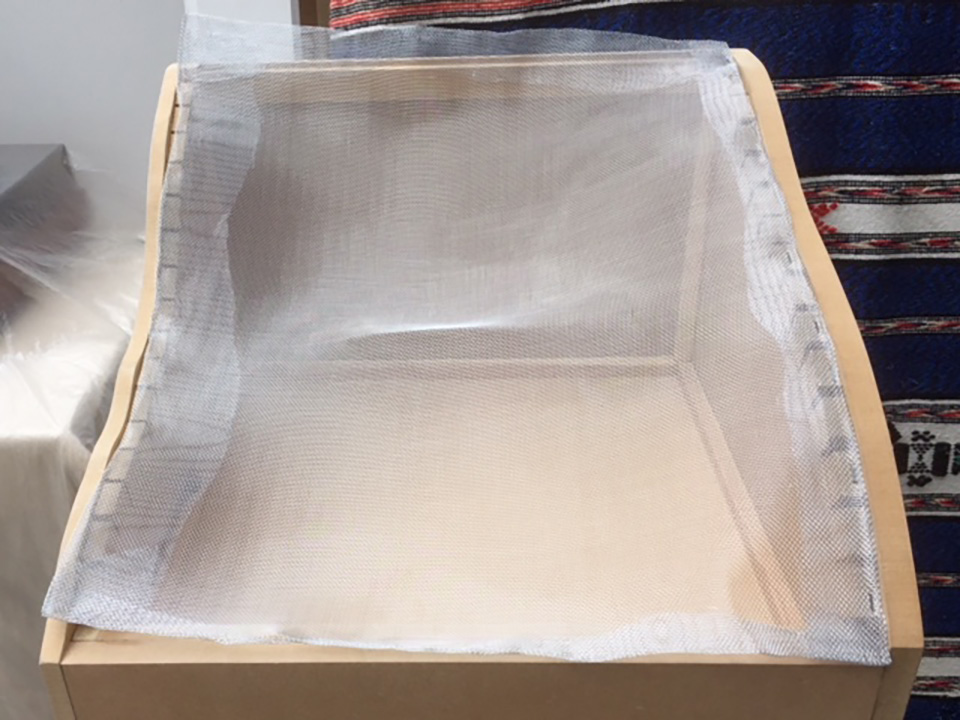
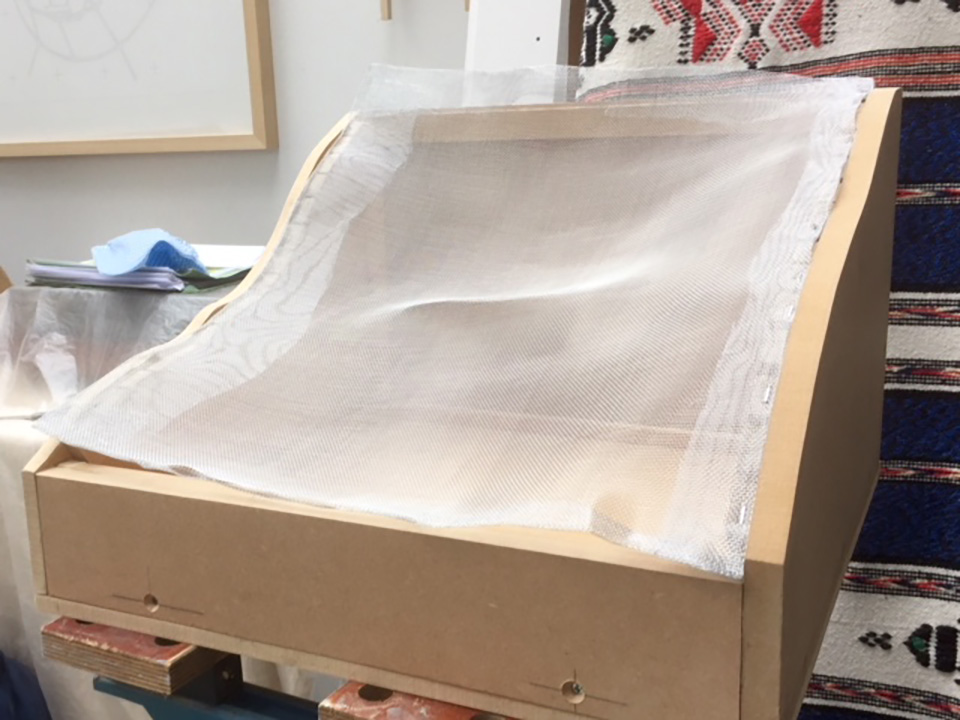
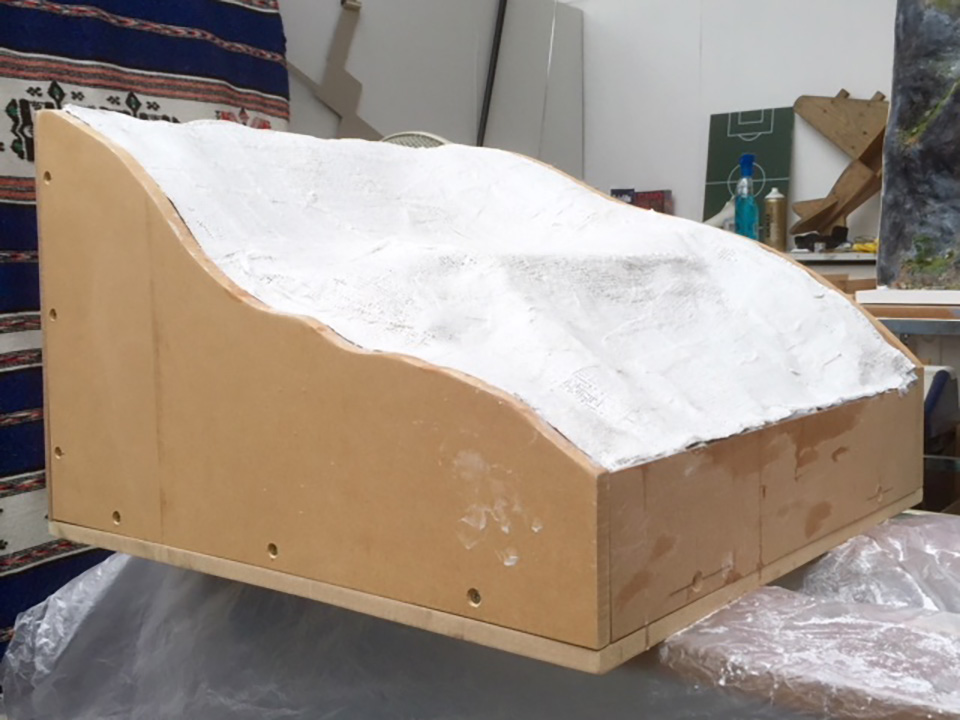
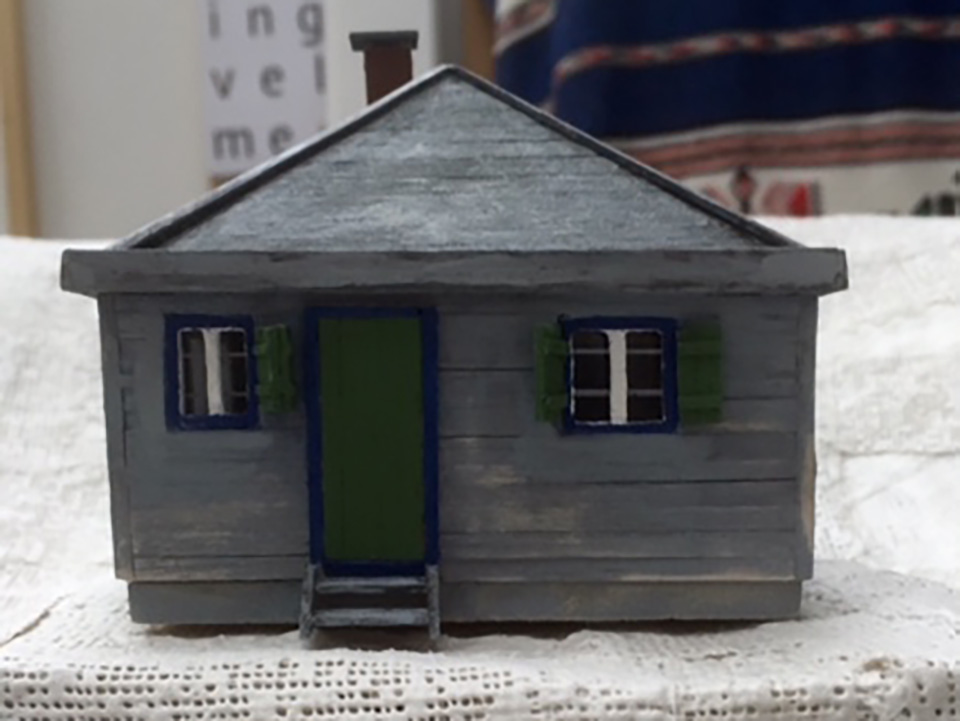
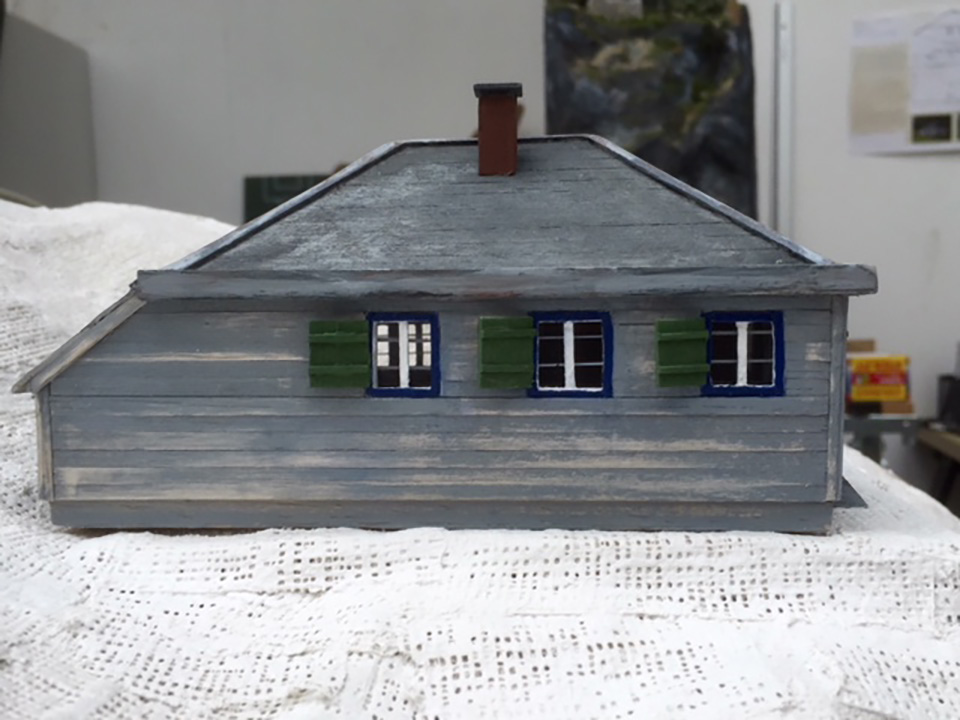
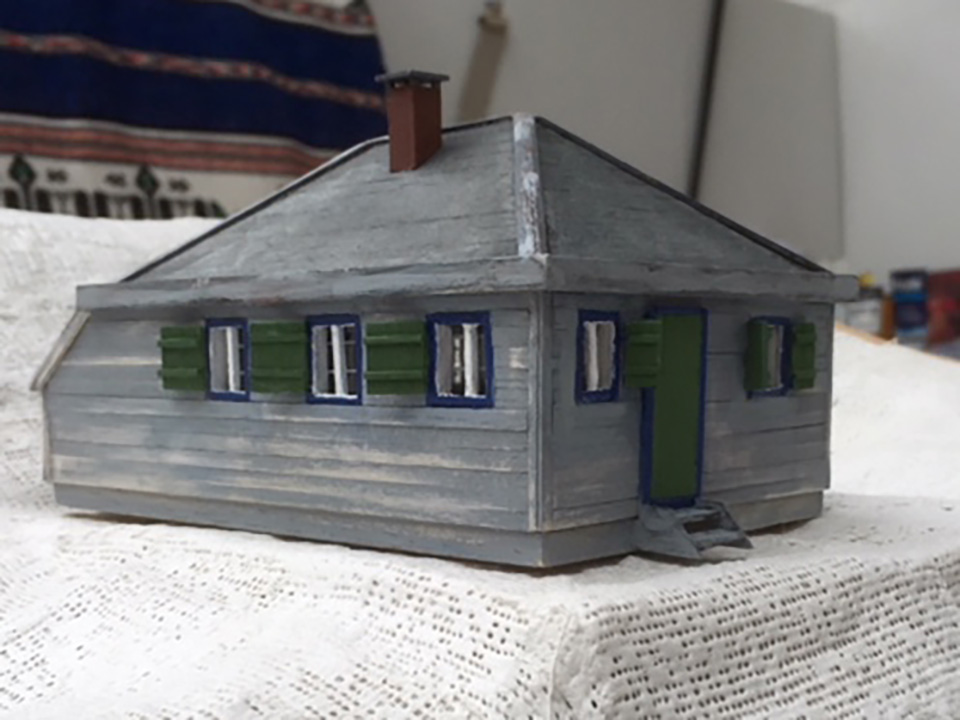
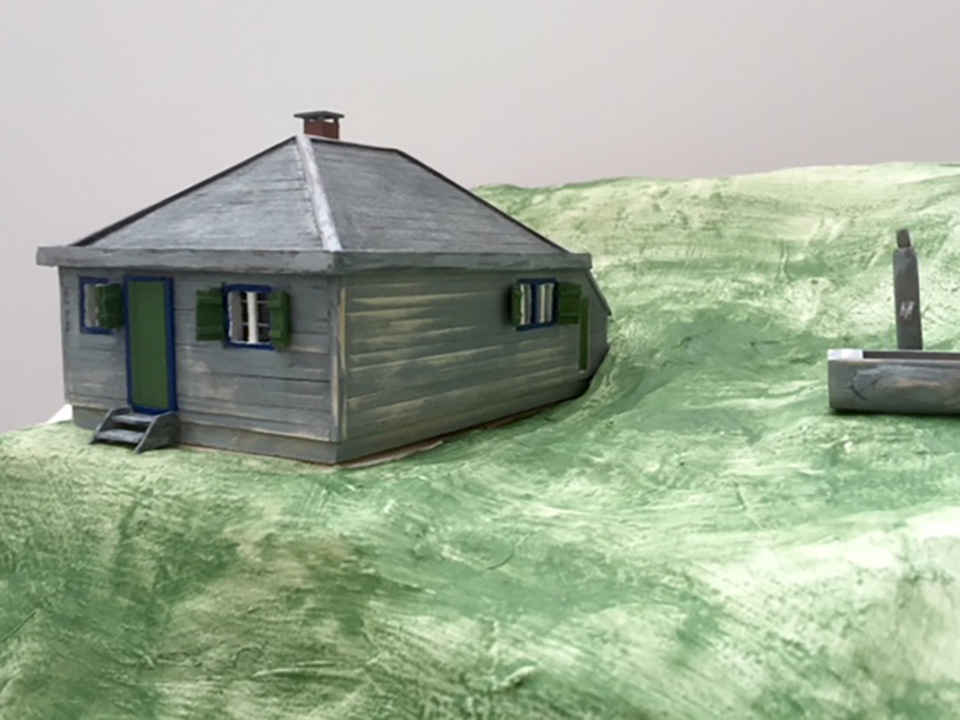
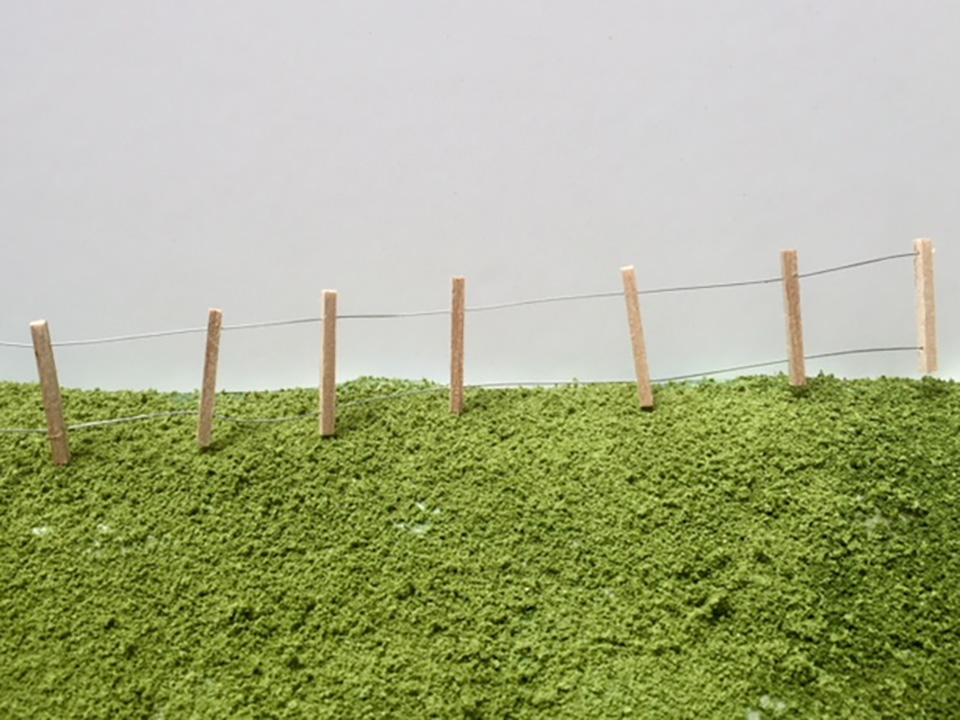
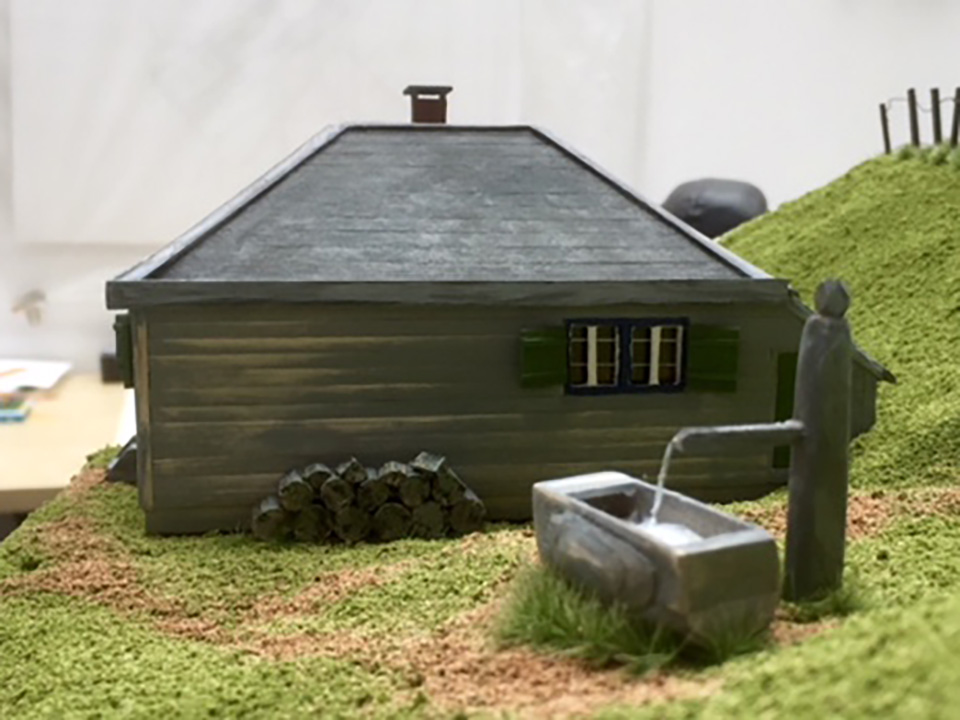
1 A palimpsest is a surface on which text has been written, erased and re-inscribed.
2 In The Black Notebooks, Heidegger states that “Today (March 1932) I am in all clarity at a place from which my entire previous literary output (…) has become alien to me. Alien like a path brought to an impasse, a path overgrown with grass and vegetation- a path which yet retains the fact that it leads to Da-sein as temporality. A path on whose edges stands much that is contemporary and mendacious – often in such a way that those path markings are taken as more important than the path itself” (a f p 102-104, 261).
3 Taken from ‘The Thinker as Poet’ (1947) and published in Poetry Language Thought.
4 Found in the collected volume, Lightduress and published by Integer Books in 2005.
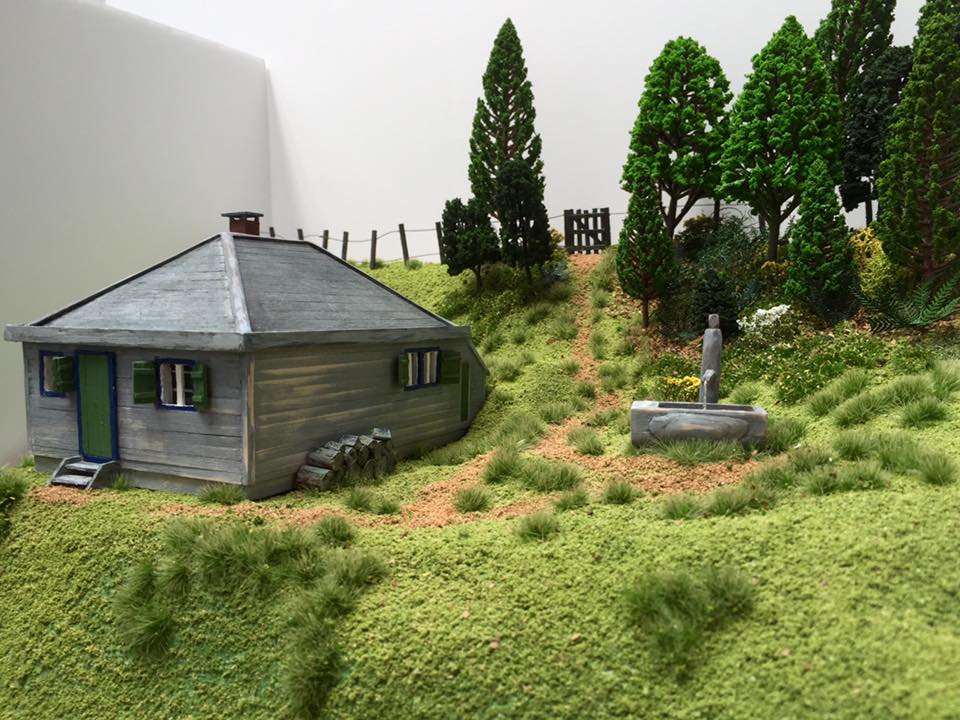
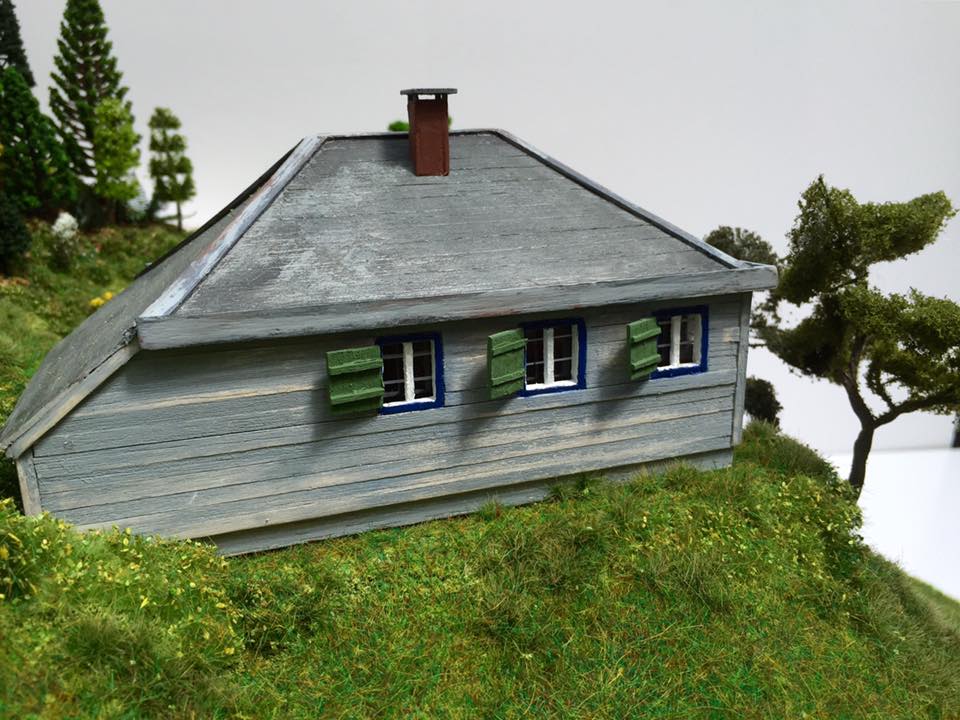
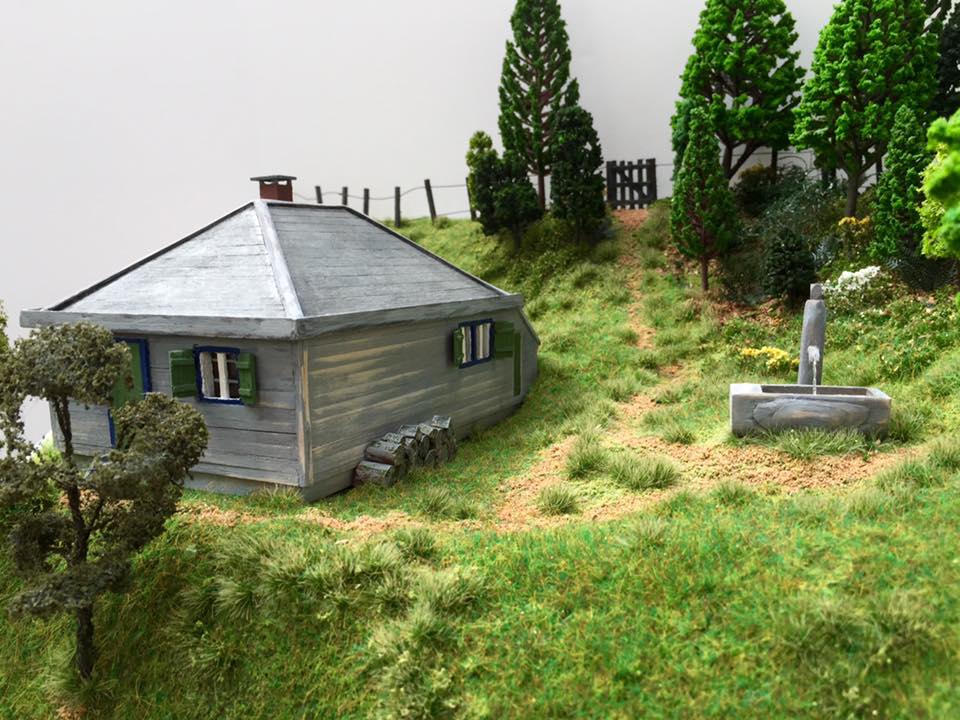
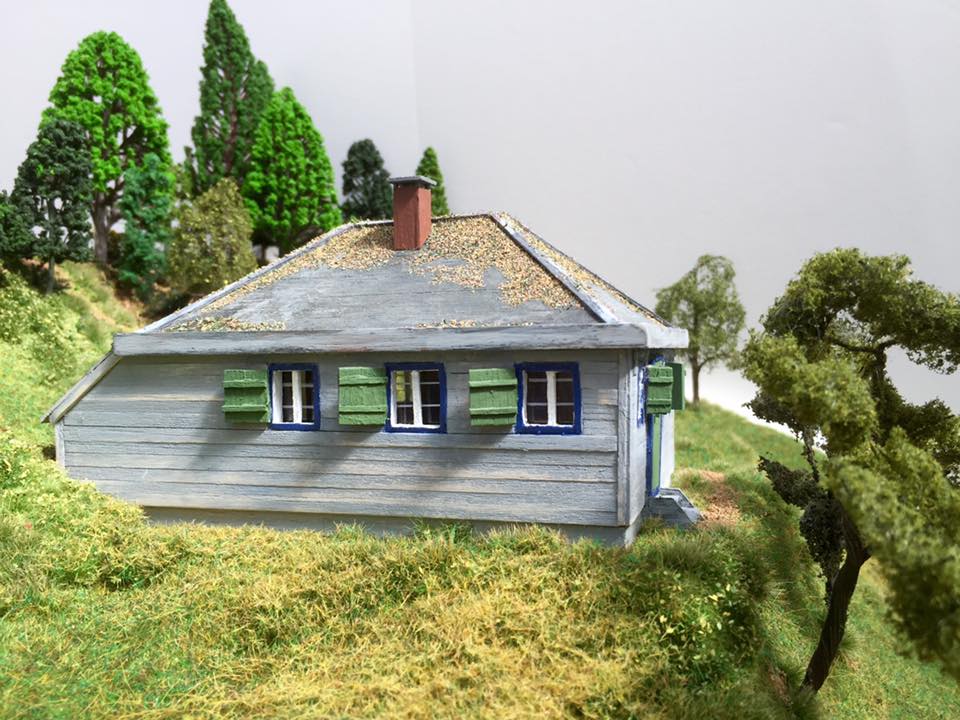
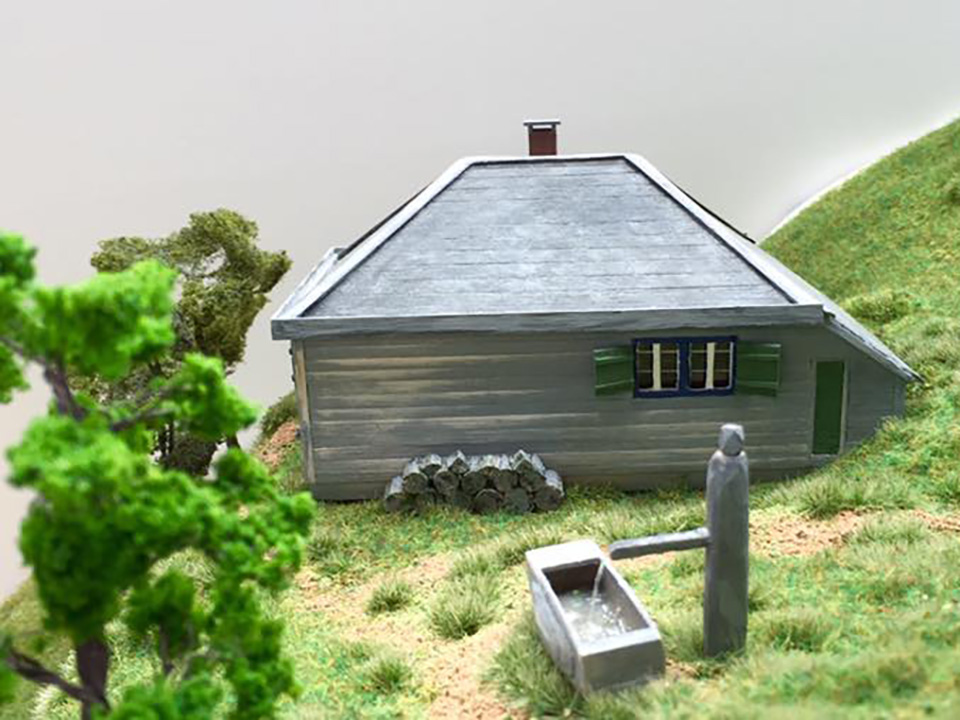
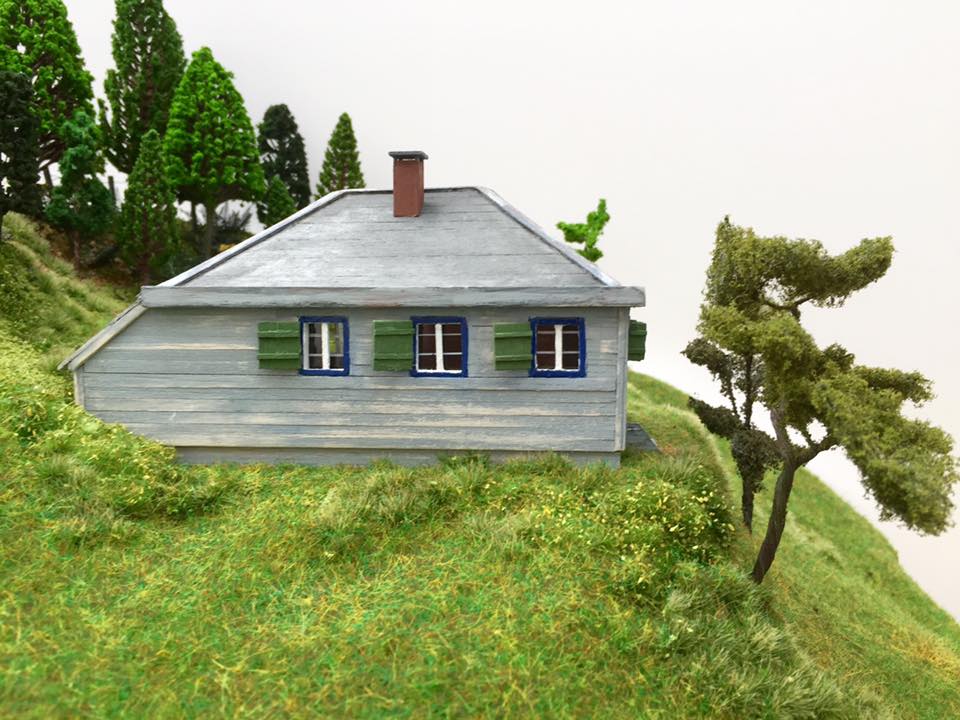
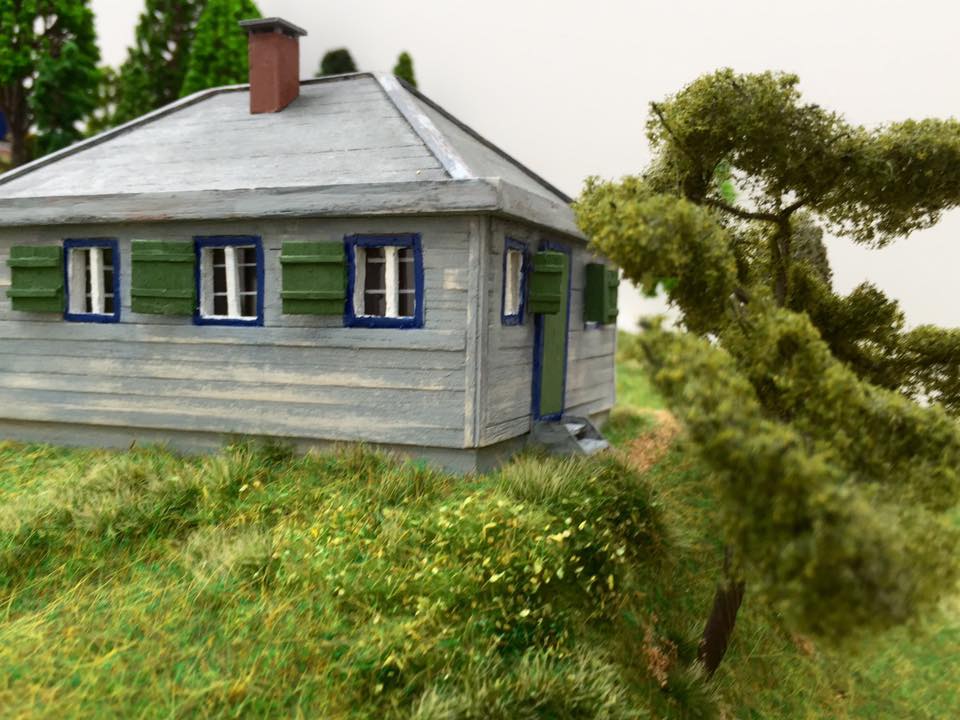
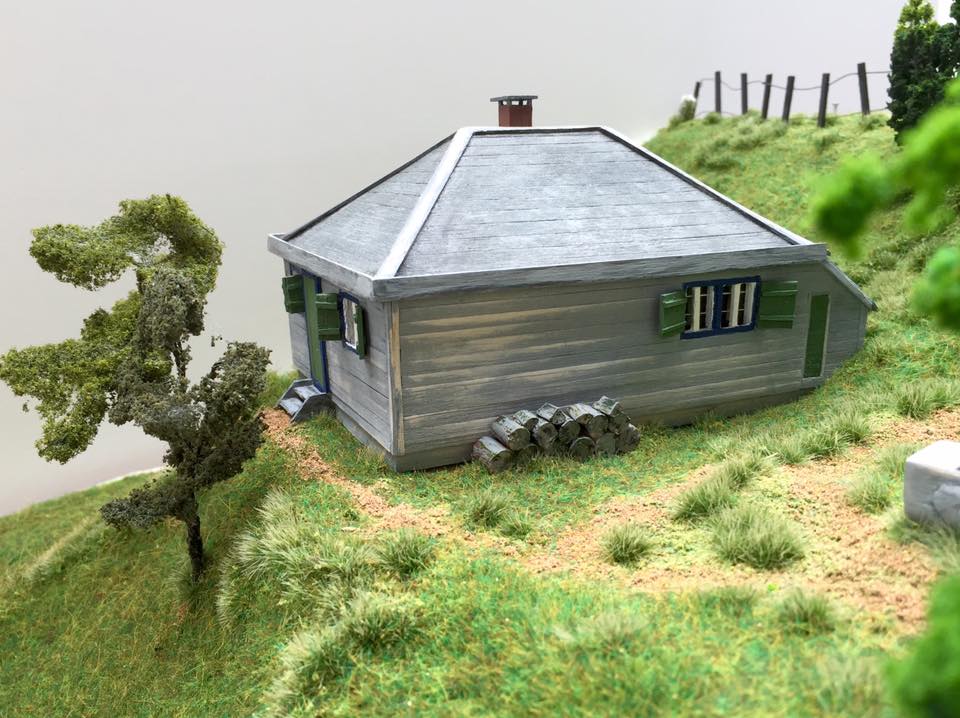
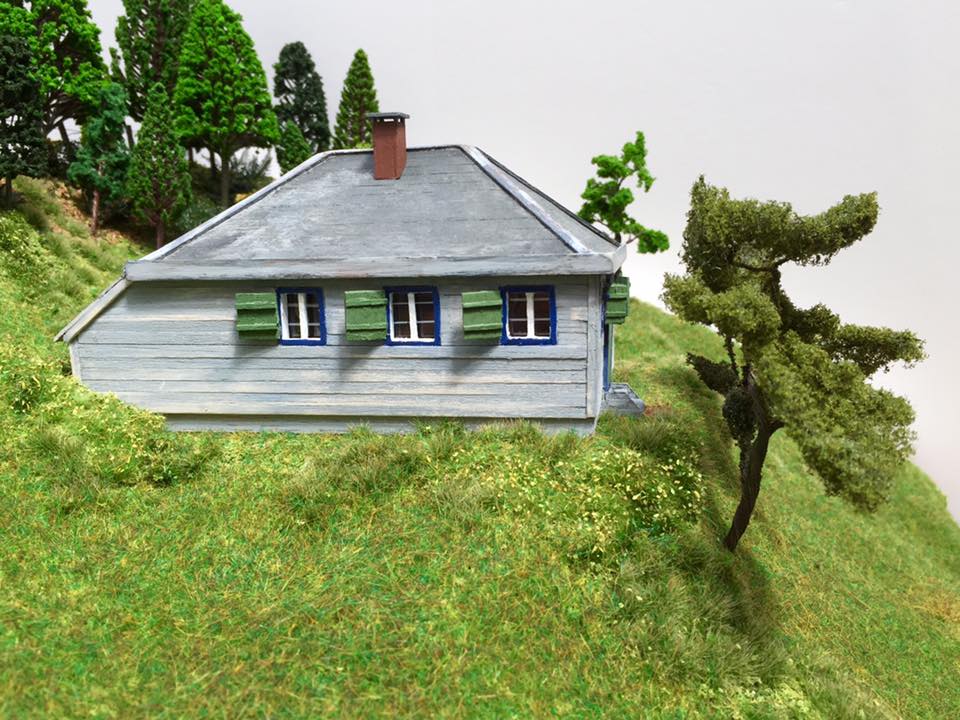
Baer, Ulrich. 2000. Remnants of Song: Trauma and the Experience of Modernity in Charles Baudelaire and Paul Celan. Stanford, CA: Stanford University Press.
Celan, Paul. 2005. Lightduress, trans. P. Joris. Los Angeles CA: Green Integer Books.
Faye, Emmanuel. 2009. Heidegger: the Introduction of Nazism into Philosophy. Yale CT: Yale University Press.
Felstiner, John. 2001. Poet Survivor Jew. New Haven CT; Yale University Press.
Heidegger, Martin. 2008. Letters to His Wife (selected and edited by Gertrude Heidegger). R.D.V. Glasgow, ed. Cambridge UK: Polity Press.
Heidegger, Martin.1975. Poetry Language Thought, trans. A. Hofstadter. New York NY: Harper Perennial.
Heidegger, Martin 2016. Ponderings II-VI, Black Notebooks 1931-1938. Translated by Richard Rojcewicz. Bloomington IN: Indiana University Press.
Kligerman, Eric. 2007. Sites of the Uncanny: Paul Celan, Specularity and the Visual Arts. New York, NY and Berlin: De Gruyter.
Lacoue-Labarthe, Philippe. 1998. Poetry as Experience, trans. Andrea Tarnowski. Stanford CA: Stanford University Press.
Lyon, J. K. 2006. Paul Celan and Martin Heidegger: An Unresolved Conversation, Baltimore MA: John Hopkins University Press.
Macfarlane, Robert. 2012. Old Ways: a Journey on Foot. London UK: Hamish Hamilton.
Magris, Claudio.2001. Danube. London, UK: Harvill Press.
Maier-Katkin, Daniel. 2010. Stranger from Abroad: Hannah Arendt, Martin Heidegger, Friendship and Forgiveness. New York: Norton Press.
Mugerauer, Robert. 2008. Heidegger and Homecoming: the Leitmotif in the Later Writings. Toronto Canada: University of Toronto Press.
Ott, Hugo.1994. Martin Heidegger: a Political Life, trans. A. Blunden. London UK: Fontana.
Pöggeler, Otto.1997. The Paths of Heidegger’s Life and Though, trans. J. Bailiff. New Jersey NY: Humanities Press International.
Safrinski, R. 1999. Martin Heidegger: Between Good and Evil, trans. E. Osers. Cambridge MA: Harvard University Press.
Sheehan, T. (ed) 2009 edition. Martin Heidegger, The Man and the Thinker, New Brunswick Canada: Transaction Press.
Sharr, Adam. 2006. Heidegger’s Hut. Cambridge MA: MIT Press.
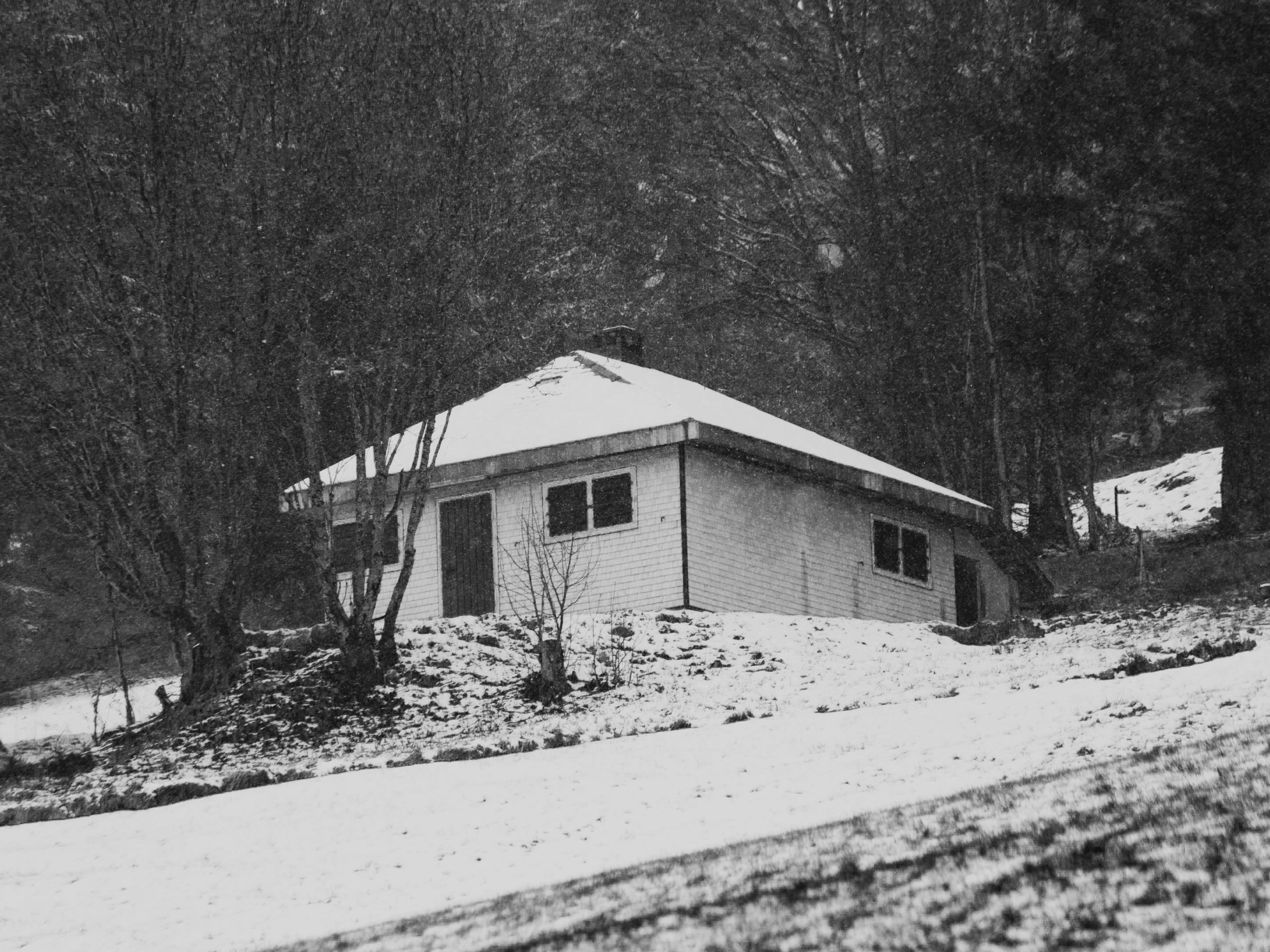
This website is under construction. Register and get notified when it's launched.
